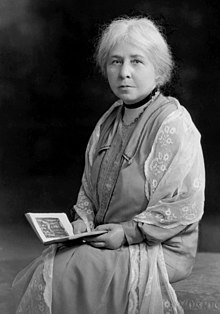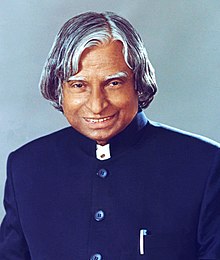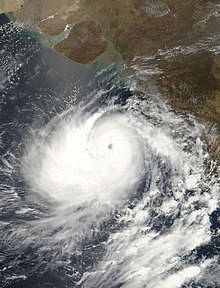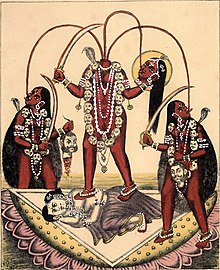Portal:India
Portal maintenance status: (June 2018)
|
Introduction


India, officially the Republic of India, is a country in South Asia. It is the seventh-largest country by area; the most populous country as of June 2023; and from the time of its independence in 1947, the world's most populous democracy. Bounded by the Indian Ocean on the south, the Arabian Sea on the southwest, and the Bay of Bengal on the southeast, it shares land borders with Pakistan to the west; China, Nepal, and Bhutan to the north; and Bangladesh and Myanmar to the east. In the Indian Ocean, India is in the vicinity of Sri Lanka and the Maldives; its Andaman and Nicobar Islands share a maritime border with Thailand, Myanmar, and Indonesia. (Full article...)
 Featured article – show another
Featured article – show another
-
Image 1
The black stork (Ciconia nigra) is a large bird in the stork family Ciconiidae. It was first described by Carl Linnaeus in the 10th edition of his Systema Naturae. Measuring on average 95 to 100 cm (37 to 39 in) from beak tip to end of tail with a 145-to-155 cm (57-to-61 in) wingspan, the adult black stork has mainly black plumage, with white underparts, long red legs and a long pointed red beak. A widespread but uncommon species, it breeds in scattered locations across Europe (predominantly in Portugal and Spain, and central and eastern parts), and east across the Palearctic to the Pacific Ocean. It is a long-distance migrant, with European populations wintering in tropical Sub-Saharan Africa, and Asian populations in the Indian subcontinent. When migrating between Europe and Africa, it avoids crossing broad expanses of the Mediterranean Sea and detours via the Levant in the east, the Strait of Sicily in the center, or the Strait of Gibraltar in the west. An isolated non-migratory population lives in Southern Africa.
Unlike the closely related white stork, the black stork is a shy and wary species. It is seen singly or in pairs, usually in marshy areas, rivers or inland waters. It feeds on amphibians, small fish and insects, generally wading slowly in shallow water stalking its prey. Breeding pairs usually build nests in large forest trees—most commonly deciduous but also coniferous—which can be seen from long distances, as well as on large boulders, or under overhanging ledges in mountainous areas. The female lays two to five greyish-white eggs, which become soiled over time in the nest. Incubation takes 32 to 38 days, with both sexes sharing duties, and fledging takes 60 to 71 days. (Full article...) -
Image 2

India, officially the Republic of India, is a country in South Asia. It is the seventh-largest country by area; the most populous country as of June 2023; and from the time of its independence in 1947, the world's most populous democracy. Bounded by the Indian Ocean on the south, the Arabian Sea on the southwest, and the Bay of Bengal on the southeast, it shares land borders with Pakistan to the west; China, Nepal, and Bhutan to the north; and Bangladesh and Myanmar to the east. In the Indian Ocean, India is in the vicinity of Sri Lanka and the Maldives; its Andaman and Nicobar Islands share a maritime border with Thailand, Myanmar, and Indonesia.
Modern humans arrived on the Indian subcontinent from Africa no later than 55,000 years ago. Their long occupation, predominantly in isolation as hunter-gatherers, has made the region highly diverse, second only to Africa in human genetic diversity. Settled life emerged on the subcontinent in the western margins of the Indus river basin 9,000 years ago, evolving gradually into the Indus Valley Civilisation of the third millennium BCE. By at least 1200 BCE, an archaic form of Sanskrit, an Indo-European language, had diffused into India from the northwest. Its hymns recorded the dawning of Hinduism in India. The Dravidian languages of India were supplanted in the northern and western regions. By 400 BCE, caste had emerged within Hinduism, and Buddhism and Jainism had arisen, proclaiming social orders unlinked to heredity. Early political consolidations gave rise to the loose-knit Maurya and Gupta Empires based in the Ganges Basin. Their collective era was suffused with wide-ranging creativity, but also marked by the declining status of women, and the incorporation of untouchability into an organised system of belief. In South India, the Middle kingdoms exported Dravidian-languages scripts and religious cultures to the kingdoms of Southeast Asia. (Full article...) -
Image 3
INS Vikrant (from Sanskrit vikrānta, "courageous") was a Majestic-class aircraft carrier of the Indian Navy. The ship was laid down as HMS Hercules for the British Royal Navy during World War II, but was put on hold when the war ended. India purchased the incomplete carrier in 1957, and construction was completed in 1961. Vikrant was commissioned as the first aircraft carrier of the Indian Navy and played a key role in enforcing the naval blockade of East Pakistan during the Indo-Pakistani War of 1971.
In its later years, the ship underwent major refits to embark modern aircraft, before being decommissioned in January 1997. She was preserved as a museum ship in Naval Docks, Mumbai until 2012. In January 2014, the ship was sold through an online auction and scrapped in November 2014 after final clearance from the Supreme Court. (Full article...) -
Image 4Anbe Sivam (transl. Love Is God) is a 2003 Indian Tamil-language slice-of-life drama film directed by Sundar C and produced by Lakshmi Movie Makers. The film was written by Kamal Haasan, and Madhan provided the dialogues. Anbe Sivam stars Haasan, Madhavan and Kiran Rathod, with Nassar, Santhana Bharathi, Seema and Uma Riyaz Khan playing supporting characters. It tells the story of Nallasivam and Anbarasu, two men of contrasting personalities who undertake an unexpected journey from Bhubaneswar to Chennai.
Produced on a budget of ₹120 million, Anbe Sivam takes on themes such as communism, atheism, and altruism and depicts Haasan's humanist views. The music was composed by Vidyasagar. Arthur A. Wilson served as the cinematographer and M. Prabhaharan served as the art director. (Full article...) -
Image 5
The Marwari or Malani is a rare breed of horse from the Marwar (or Jodhpur) region of Rajasthan, in north-west India. It is closely related to the Kathiawari breed of the Kathiawar peninsula of Gujarat, with which it shares an unusual inward-curving shape of the ears. It is found in all equine colours, including piebald and skewbald. It is a hardy riding horse; it may exhibit a natural ambling gait.
The Rathores, traditional rulers of the Marwar region of western India, were the first to breed the Marwari. Beginning in the 12th century, they espoused strict breeding that promoted purity and hardiness. Used throughout history as a cavalry horse by the people of the Marwar region, the Marwari was noted for its loyalty and bravery in battle. The breed deteriorated in the 1930s, when poor management practices resulted in a reduction of the breeding stock, but today has regained some of its popularity. The Marwari is used for light draught and agricultural work, as well as riding and packing. In 1995, a breed society was formed for the Marwari horse in India. The exportation of Marwari horses was banned for decades, but between 2000 and 2006, a small number of exports were allowed. Since 2008, visas allowing temporary travel of Marwari horses outside India have been available in small numbers. Though they are rare they are becoming more popular outside of India due to their unique looks. (Full article...) -
Image 6Portrait by Charles Dana Gibson, c. 1903
Margaret Ives Abbott (June 15, 1878 – June 10, 1955) was an American amateur golfer. She was the first American woman to win an Olympic event: the women's golf tournament at the 1900 Summer Olympics.
Born in Calcutta (now Kolkata), British Raj, in 1878, Abbott moved with her family to Chicago in 1884. She joined the Chicago Golf Club in Wheaton, Illinois, where she received coaching from Charles B. Macdonald and H. J. Whigham. In 1899, she traveled with her mother to Paris to study art. The following year, along with her mother, she signed up for a women's golf tournament without realizing that it was the second modern Olympics. Abbott won the tournament with a score of 47 strokes; her mother tied for seventh place. Abbott received a porcelain bowl as a prize. (Full article...) -
Image 7Phoolan Devi (Hindi: [pʰuː.lən d̪eː.ʋiː], 10 August 1963 – 25 July 2001), popularly known as the Bandit Queen, was an Indian dacoit (bandit) who became a politician, serving as a member of parliament until her assassination. She was a woman of the Mallah subcaste who grew up in poverty in a village in the state of Uttar Pradesh, where her family was on the losing side of a land dispute which caused them many problems. After being married off at the age of eleven and being sexually abused by various people, she joined a gang of dacoits. Her gang robbed higher-caste villages and held up trains and vehicles. When she punished her rapists and evaded capture by the authorities, she became a heroine to the Other Backward Classes who saw her as a Robin Hood figure. Phoolan Devi was charged in absentia for the 1981 Behmai massacre, in which twenty Thakur men were killed, allegedly on her command. After this event, the Chief Minister of Uttar Pradesh resigned, and calls to apprehend her were amplified. She surrendered two years later in a carefully negotiated settlement and spent eleven years in Gwalior prison, awaiting trial.
Phoolan Devi was released in 1994 after her charges were set aside. She subsequently became a politician and was elected as a member of parliament for the Samajwadi Party in 1996. She lost her seat in 1998, but regained it the following year. She was the incumbent at the time of her death in 2001. She was assassinated outside her house by Sher Singh Rana, who was convicted for the murder in 2014. At the time of her death, she was still fighting against the reinstituted criminal charges, having lost a 1996 appeal to the Supreme Court to have the charges dropped. Phoolan Devi's worldwide fame grew after the release of the controversial 1994 film Bandit Queen, which told her life story in a way she did not approve of. Her life has also inspired several biographies and her dictated autobiography was entitled I, Phoolan Devi. There are varying accounts of her life because she told differing versions to suit her changing circumstances. (Full article...) -
Image 8
Western Ganga was an important ruling dynasty of ancient Karnataka in India which lasted from about 350 to 999 CE. They are known as "Western Gangas" to distinguish them from the Eastern Gangas who in later centuries ruled over Kalinga (modern Odisha and Northern Andhra Pradesh). The general belief is that the Western Gangas began their rule during a time when multiple native clans asserted their freedom due to the weakening of the Pallava empire in South India, a geo-political event sometimes attributed to the southern conquests of Samudra Gupta. The Western Ganga sovereignty lasted from about 350 to 550 CE, initially ruling from Kolar and later, moving their capital to Talakadu on the banks of the Kaveri River in modern Mysore district.
After the rise of the imperial Chalukyas of Badami, the Gangas accepted Chalukya overlordship and fought for the cause of their overlords against the Pallavas of Kanchi. The Chalukyas were replaced by the Rashtrakutas of Manyakheta in 753 CE as the dominant power in the Deccan. After a century of struggle for autonomy, the Western Gangas finally accepted Rashtrakuta overlordship and successfully fought alongside them against their foes, the Chola Dynasty of Tanjavur. In the late 10th century, north of Tungabhadra river, the Rashtrakutas were replaced by the emerging Western Chalukya Empire and the Chola Dynasty saw renewed power south of the Kaveri river. The defeat of the Western Gangas by Cholas around 1000 resulted in the end of the Ganga influence over the region. (Full article...) -
Image 9Portrait by Rudolf Swoboda, 1888
Mohammed Abdul Karim (1863 — 20 April 1909), also known as "the Munshi", was an Indian attendant of Queen Victoria. He served her during the final fourteen years of her reign, gaining her maternal affection over that time.
Karim was born the son of a hospital assistant at Lalitpur, near Jhansi in British India. In 1887, the year of Victoria's Golden Jubilee, Karim was one of two Indians selected to become servants to the Queen. Victoria came to like him a great deal and gave him the title of "Munshi" ("clerk" or "teacher"). Victoria appointed him to be her Indian Secretary, showered him with honours, and obtained a land grant for him in India. (Full article...) -
Image 10
The Chalukya dynasty ([tʃaːɭukjə]) was a Classical Indian dynasty that ruled large parts of southern and central India between the 6th and the 12th centuries. During this period, they ruled as three related yet individual dynasties. The earliest dynasty, known as the "Badami Chalukyas", ruled from Vatapi (modern Badami) from the middle of the 6th century. The Badami Chalukyas began to assert their independence at the decline of the Kadamba kingdom of Banavasi and rapidly rose to prominence during the reign of Pulakeshin II. After the death of Pulakeshin II, the Eastern Chalukyas became an independent kingdom in the eastern Deccan. They ruled from Vengi until about the 11th century. In the western Deccan, the rise of the Rashtrakutas in the middle of the 8th century eclipsed the Chalukyas of Badami before being revived by their descendants, the Western Chalukyas, in the late 10th century. These Western Chalukyas ruled from Kalyani (modern Basavakalyan) until the end of the 12th century.
The rule of the Chalukyas marks an important milestone in the history of South India and a golden age in the history of Karnataka. The political atmosphere in South India shifted from smaller kingdoms to large empires with the ascendancy of Badami Chalukyas. A Southern India-based kingdom took control and consolidated the entire region between the Kaveri and the Narmada rivers. The rise of this empire saw the birth of efficient administration, overseas trade and commerce and the development of new style of architecture called "Chalukyan architecture". Kannada literature, which had enjoyed royal support in the 9th century Rashtrakuta court found eager patronage from the Western Chalukyas in the Jain and Veerashaiva traditions. The 11th century saw the patronage of Telugu literature under the Eastern Chalukyas. (Full article...) -
Image 11
Margaret Alice Murray FSA Scot FRAI (13 July 1863 – 13 November 1963) was an Anglo-Indian Egyptologist, archaeologist, anthropologist, historian, and folklorist. The first woman to be appointed as a lecturer in archaeology in the United Kingdom, she worked at University College London (UCL) from 1898 to 1935. She served as president of the Folklore Society from 1953 to 1955, and published widely over the course of her career.
Born to a wealthy middle-class English family in Calcutta, British India, Murray divided her youth between India, Britain, and Germany, training as both a nurse and a social worker. Moving to London, in 1894 she began studying Egyptology at UCL, developing a friendship with department head Flinders Petrie, who encouraged her early academic publications and appointed her junior lecturer in 1898. In 1902–03, she took part in Petrie's excavations at Abydos, Egypt, there discovering the Osireion temple and the following season investigated the Saqqara cemetery, both of which established her reputation in Egyptology. Supplementing her UCL wage by giving public classes and lectures at the British Museum and Manchester Museum, it was at the latter in 1908 that she led the unwrapping of Khnum-nakht, one of the mummies recovered from the Tomb of two Brothers – the first time that a woman had publicly unwrapped a mummy. Recognising that British Egyptomania reflected the existence of a widespread public interest in Ancient Egypt, Murray wrote several books on Egyptology targeted at a general audience. (Full article...) -
Image 12The political history of medieval Karnataka spans the 4th to the 16th centuries in Karnataka region of India. The medieval era spans several periods of time from the earliest native kingdoms and imperialism; the successful domination of the Gangetic plains in northern India and rivalry with the empires of Tamilakam over the Vengi region; and the domination of the southern Deccan and consolidation against Muslim invasion. The origins of the rise of the Karnataka region as an independent power date back to the fourth-century birth of the Kadamba Dynasty of Banavasi which was the earliest of the native rulers to conduct administration in the native language of Kannada in addition to the official Sanskrit.
In the southern regions of Karnataka, the Western Gangas of Talakad were contemporaries of the Kadambas. The Kadambas and Gangas were followed by the imperial dynasties of the Badami Chalukya Empire, the Rashtrakuta Empire, the Western Chalukya Empire, the Hoysala Empire and the Vijayanagara Empire, all patronising the ancient Indic religions while showing tolerance to the new cultures arriving from the west of the subcontinent. The Muslim invasion of the Deccan resulted in the breaking away of the feudatory Sultanates in the 14th century. The rule of the Bahamani Sultanate of Bidar and the Bijapur Sultanate from the northern Deccan region caused a mingling of the ancient Hindu traditions with the nascent Islamic culture in the region. The hereditary ruling families and clans ably served the large empires and upheld the local culture and traditions. The fall of the Vijayanagara Empire in 1565 brought about a slow disintegration of Kannada-speaking regions into minor kingdoms that struggled to maintain autonomy in an age dominated by foreigners until unification and independence in 1947. (Full article...) -
Image 13Nanakramguda skyline
Hyderabad (/ˈhaɪdərəbæd/ HY-dər-ə-bad; ISO: Haidarābād, Telugu: [ˈɦaɪ̯daɾaːbaːd] ⓘ, Urdu: [ˈɦɛːdəɾaːbaːd]) is the capital and largest city of the Indian state of Telangana. It occupies 650 km2 (250 sq mi) on the Deccan Plateau along the banks of the Musi River, in the northern part of Southern India. With an average altitude of 542 m (1,778 ft), much of Hyderabad is situated on hilly terrain around artificial lakes, including the Hussain Sagar lake, predating the city's founding, in the north of the city centre. According to the 2011 census of India, Hyderabad is the fourth-most populous city in India with a population of 6.9 million residents within the city limits, and has a population of 9.7 million residents in the metropolitan region, making it the sixth-most populous metropolitan area in India. With an output of US$ 95 billion, Hyderabad has the sixth-largest urban economy in India.
The Qutb Shahi dynasty's Muhammad Quli Qutb Shah established Hyderabad in 1591 to extend the capital beyond the fortified Golconda. In 1687, the city was annexed by the Mughals. In 1724, Asaf Jah I, the Mughal viceroy, declared his sovereignty and founded the Asaf Jahi dynasty, also known as the Nizams. Hyderabad served as the imperial capital of the Asaf Jahis from 1769 to 1948. As the capital of the princely state of Hyderabad, the city housed the British Residency and cantonment until Indian independence in 1947. Hyderabad was annexed by the Indian Union in 1948 and continued as a capital of Hyderabad State from 1948 to 1956. After the introduction of the States Reorganisation Act of 1956, Hyderabad was made the capital of the newly formed Andhra Pradesh. In 2014, Andhra Pradesh was split to form the state of Telangana, and Hyderabad became the joint capital of the two states with a transitional arrangement scheduled to end in 2024. Since 1956, the city has housed the Rashtrapati Nilayam, the winter office of the president of India. (Full article...) -
Image 14
Shefali Shah (née Shetty; born 22 May 1973) is an Indian actress of film, television and theatre. Working primarily in independent Hindi films, she has received multiple local and foreign accolades for her performances. Shah's acting career started on the Gujarati stage before she debuted on television in 1993. After small parts on television and a brief stint with cinema in Rangeela (1995), she gained wider recognition in 1997 for her role in the popular series Hasratein. This was followed by lead roles in the TV series Kabhie Kabhie (1997) and Raahein (1999). A supporting role in the crime film Satya (1998) won her positive notice and a Filmfare Critics Award, and she soon shifted her focus to film acting starting with a lead role in the Gujarati drama Dariya Chhoru (1999).
Shah was selective about her roles through the following decades, resulting in intermittent film work, mostly in character parts and often to appreciation from critics. She appeared in the international co-production Monsoon Wedding (2001) and the mainstream comedy-drama Waqt: The Race Against Time (2005). In 2007, her portrayal of Kasturba Gandhi in the biographical drama Gandhi, My Father won her the Best Actress prize at the Tokyo International Film Festival, and she received the National Film Award for Best Supporting Actress for the drama film The Last Lear. Among her subsequent film roles, she played a leading part in Kucch Luv Jaisaa (2011) and was noted for her work in the social problem film Lakshmi (2014) and the ensemble drama Dil Dhadakne Do (2015). (Full article...) -
Image 15

Darjeeling (/dɑːrˈdʒiːlɪŋ/, Nepali: [ˈdard͡ziliŋ], Bengali: [ˈdarˌdʒiliŋ]) is a city in the northernmost region of the Indian state of West Bengal. Located in the Eastern Himalayas, it has an average elevation of 2,045 metres (6,709 ft). To the west of Darjeeling lies the easternmost province of Nepal, to the east the Kingdom of Bhutan, to the north the Indian state of Sikkim, and farther north the Tibet Autonomous Region region of China. Bangladesh lies to the south and southeast, and most of the state of West Bengal lies to the south and southwest, connected to the Darjeeling region by a narrow tract. Kangchenjunga, the world's third-highest mountain, rises to the north and is prominently visible on clear days.
In the early 19th century, during East India Company rule in India, Darjeeling was identified as a potential summer retreat for British officials, soldiers and their families. The narrow mountain ridge was leased from the Kingdom of Sikkim, and eventually annexed to British India. Experimentation with growing tea on the slopes below Darjeeling was highly successful. Thousands of labourers were recruited chiefly from Nepal to clear the forests, build European-style cottages and work in the tea plantations. The widespread deforestation displaced the indigenous peoples. Residential schools were established in and around Darjeeling for the education of children of the domiciled British in India. By the late-19th century, a novel narrow-gauge mountain railway, the Darjeeling Himalayan Railway, was bringing summer residents into the town and carrying a freight of tea out for export to the world. After India's independence in 1947, as the British left Darjeeling, its cottages were purchased by wealthy Indians from the plains and its tea plantations by out-of-town Indian business owners and conglomerates. (Full article...) -
Image 16
Prince Sadruddin Aga Khan (17 January 1933 – 12 May 2003) was a French-born statesman and activist who served as United Nations High Commissioner for Refugees from 1966 to 1977, during which he reoriented the agency's focus beyond Europe and prepared it for an explosion of complex refugee issues. He was also a proponent of greater collaboration between non-governmental organizations (NGOs) and UN agencies. The Prince's interest in ecological issues led him to establish the Bellerive Foundation in the late 1970s, and he was a knowledgeable and respected collector of Islamic art.
Born in Paris, France, he was the son of Sir Sultan Mahomed Shah Aga Khan and Princess Andrée Aga Khan. He married twice, but had no children of his own. Prince Sadruddin died of cancer at the age of 70, and was buried in Switzerland. (Full article...) -
Image 17
Freida Selena Pinto (born 18 October 1984) is an Indian actress who has appeared mainly in American and British films. Born and raised in Mumbai, Maharashtra, she resolved at a young age to become an actress. As a student at St. Xavier's College, Mumbai she took part in amateur plays. After graduation, she briefly worked as a model and then as a television presenter.
Pinto rose to prominence with her film debut in the drama Slumdog Millionaire (2008), winning a SAG Award and earning a nomination for the BAFTA Award for Best Supporting Actress. She earned critical acclaim for her roles in Miral (2010), Trishna (2011), and Desert Dancer (2014). She also saw commercial success with the science fiction film Rise of the Planet of the Apes (2011), and the epic fantasy action film Immortals (2011). Pinto's other notable roles include You Will Meet a Tall Dark Stranger (2010), Love Sonia (2018), Hillbilly Elegy (2020), and Mr. Malcolm's List (2022). She also starred in the Showtime miniseries Guerrilla (2017), and had a recurring role in the Hulu series The Path (2018). (Full article...) -
Image 18
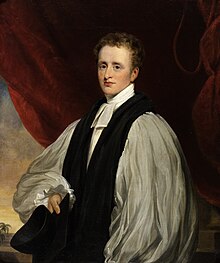
Reginald Heber (21 April 1783 – 3 April 1826) was an English Anglican bishop, a man of letters, and hymn-writer. After 16 years as a country parson, he served as Bishop of Calcutta until his death at the age of 42. The son of a rich landowner and cleric, Heber gained fame at the University of Oxford as a poet. After graduation he made an extended tour of Scandinavia, Russia and Central Europe. Ordained in 1807, he took over his father's old parish, Hodnet, Shropshire. He also wrote hymns and general literature, including a study of the works of the 17th-century cleric Jeremy Taylor.
He was consecrated Bishop of Calcutta in October 1823. He travelled widely and worked to improve the spiritual and general living conditions of his flock. Arduous duties, a hostile climate and poor health led to his collapse and death after less than three years in India. Memorials were erected there and in St Paul's Cathedral, London. A collection of his hymns appeared soon after his death. "Holy, Holy, Holy! Lord God Almighty" remains popular for Trinity Sunday, while "Brightest and Best" is frequently sung during Epiphany. (Full article...) -
Image 19Keechaka Vadham (transl. The Extermination of Keechaka) is an Indian silent film produced, directed, filmed and edited by R. Nataraja Mudaliar. The first film to have been made in South India, it was shot in five weeks at Nataraja Mudaliar's production house, India Film Company. As the members of the cast were Tamils, Keechaka Vadham is considered to be the first Tamil film. No print of it is known to have survived, making it a lost film.
The screenplay, written by C. Rangavadivelu, is based on an episode from the Virata Parva segment of the Hindu epic Mahabharata, focusing on Keechaka's attempts to woo Draupadi. The film stars Raju Mudaliar and Jeevarathnam as the central characters. (Full article...) -
Image 20Chandralekha (also spelt Chandraleka) is a 1948 Indian historical adventure film produced and directed by S. S. Vasan of Gemini Studios. Starring T. R. Rajakumari, M. K. Radha and Ranjan, the film follows two brothers (Veerasimhan and Sasankan) who fight over ruling their father's kingdom and marrying a village dancer, Chandralekha.
Development began during the early 1940s when, after two successive box-office hits, Vasan announced that his next film would be entitled Chandralekha. However, when he launched an advertising campaign for the film he only had the name of the heroine from a storyline he had rejected. Veppathur Kittoo (one of Vasan's storyboard artists) developed a story based on a chapter of George W. M. Reynolds' novel, Robert Macaire: or, The French bandit in England. Original director T. G. Raghavachari left the film more than halfway through because of disagreements with Vasan, who took over in his directorial debut. (Full article...) -
Image 21
The Western Chalukya Empire (/tʃəˈluːkjə/ chə-LOO-kyə) ruled most of the western Deccan, South India, between the 10th and 12th centuries. This Kannada-speaking dynasty is sometimes called the Kalyani Chalukya after its regal capital at Kalyani, today's Basavakalyan in the modern Bidar district of Karnataka state, and alternatively the Later Chalukya from its theoretical relationship to the 6th-century Chalukya dynasty of Badami. The dynasty is called Western Chalukyas to differentiate from the contemporaneous Eastern Chalukyas of Vengi, a separate dynasty. Before the rise of these Chalukyas, the Rashtrakuta Empire of Manyakheta controlled most of the Deccan Plateau and Central India for over two centuries. In 973, seeing confusion in the Rashtrakuta empire after a successful invasion of their capital by the ruler of the Paramara dynasty of Malwa, Tailapa II, a feudatory of the Rashtrakuta dynasty ruling from Bijapur region defeated his overlords and made Manyakheta his capital. The dynasty quickly rose to power and grew into an empire under Someshvara I who moved the capital to Kalyani.
For over a century, the two empires of South India, the Western Chalukyas and the Chola dynasty of Thanjavur fought many fierce wars to control the fertile region of Vengi. During these conflicts, the Eastern Chalukyas of Vengi, distant cousins of the Western Chalukyas but related to the Cholas by marriage, took sides with the Cholas further complicating the situation. During the rule of Vikramaditya VI, in the late 11th and early 12th centuries, the Western Chalukyas convincingly contended with the Cholas and reached a peak, ruling territories that spread over most of the Deccan, between the Narmada River in the north and Kaveri River in the south. His exploits were not limited to the south for even as a prince, during the rule of Someshvara I, he had led successful military campaigns as far east as modern Bihar and Bengal. During this period the other major ruling families of the Deccan, the Hoysala Empire, the Seuna dynasty, the Kakatiya dynasty and the Kalachuris of Kalyani, were subordinates of the Western Chalukyas and gained their independence only when the power of the Chalukya waned during the later half of the 12th century. (Full article...) -
Image 22
Kaikhosru Shapurji Sorabji (born Leon Dudley Sorabji; 14 August 1892 – 15 October 1988) was an English composer, music critic, pianist and writer whose music, written over a period of seventy years, ranges from sets of miniatures to works lasting several hours. One of the most prolific 20th-century composers, he is best known for his piano pieces, notably nocturnes such as Gulistān and Villa Tasca, and large-scale, technically intricate compositions, which include seven symphonies for piano solo, four toccatas, Sequentia cyclica and 100 Transcendental Studies. He felt alienated from English society by reason of his homosexuality and mixed ancestry, and had a lifelong tendency to seclusion.
Sorabji was educated privately. His mother was English and his father a Parsi businessman and industrialist from India, who set up a trust fund that freed his family from the need to work. Although Sorabji was a reluctant performer and not a virtuoso, he played some of his music publicly between 1920 and 1936. In the late 1930s, his attitude shifted and he imposed restrictions on performance of his works, which he lifted in 1976. His compositions received little exposure in those years and he remained in public view mainly through his writings, which include the books Around Music and Mi contra fa: The Immoralisings of a Machiavellian Musician. During this time, he also left London and eventually settled in the village of Corfe Castle, Dorset. Information on Sorabji's life, especially his later years, is scarce, with most of it coming from the letters he exchanged with his friends. (Full article...) -
Image 23Ganges river dolphin breaking the surface
South Asian river dolphins are toothed whales in the genus Platanista, which inhabit the waterways of the Indian subcontinent. They were historically considered to be one species (P. gangetica) with the Ganges river dolphin and the Indus river dolphin being subspecies (P. g. gangetica and P. g. minor respectively). Genetic and morphological evidence led to their being described as separate species in 2021. The Ganges and Indus river dolphins are estimated to have diverged 550,000 years ago. They are the only living members of the family Platanistidae and the superfamily Platanistoidea. Fossils of ancient relatives date to the late Oligocene.
South Asian river dolphins are small but stocky cetaceans with long snouts or rostra, broad flippers, and small dorsal fins. They have several unusual features. Living in murky river waters, they have eyes that are tiny and lensless; the dolphins rely instead on echolocation for navigation. The skull has large crests over the melon, which help direct their echolocation signals. These dolphins prey mainly on fish and shrimp and hunt them throughout the water column. They are active through the day and are sighted in small groups. Both species are listed as endangered by the IUCN Red List of mammals. Major threats include dams, barrages, fishing nets, and both chemical and acoustic pollution. (Full article...) -
Image 24
Arthur Edward Jeune Collins (18 August 1885 – 11 November 1914) was an English cricketer and soldier. He held, for 116 years, the record of highest score in cricket: as a 13-year-old schoolboy, he scored 628 not out over four afternoons in June 1899. Collins's record-making innings drew a large crowd and increasing media interest; spectators at the Old Cliftonian match being played nearby were drawn away to watch the junior school house cricket match in which Collins was playing. Despite this achievement, Collins never played first-class cricket. Collins's 628 not out stood as the record score until January 2016 when an Indian boy, Pranav Dhanawade, scored 1009 in a single innings.
Collins joined the British Army in 1902 and studied at the Royal Military Academy, Woolwich, before becoming an officer in the Royal Engineers. He served in France during the First World War, where he was killed in action in 1914 during the First Battle of Ypres. Collins had been mentioned in despatches and also represented the Royal Military Academy at cricket and rugby union. (Full article...) -
Image 25
The Indian roller (Coracias benghalensis) is a bird of the family Coraciidae. It is 30–34 cm (12–13 in) long with a wingspan of 65–74 cm (26–29 in) and weighs 166–176 g (5.9–6.2 oz). The face and throat are pinkish, the head and back are brown, with blue on the rump and contrasting light and dark blue on the wings and tail. The bright blue markings on the wing are prominent in flight. The sexes are similar in appearance. Two subspecies are recognised.
The Indian roller occurs widely from West Asia to the Indian subcontinent. Often found perched on roadside trees and wires, it is common in open grassland and scrub forest habitats, and has adapted well to human-modified landscapes. It mainly feeds on insects, especially beetles. The species is best known for the aerobatic displays of males during the breeding season. Adult males and females form pair bonds and raise the young together. The female lays 3–5 eggs in a cavity or crevice, which is lined with a thin mat of straw or feathers. The roller is the state bird of three Indian states. It is listed as a species of least concern on the IUCN Red List. (Full article...)
Selected pictures
-
Image 1Photograph: Yann; edit: Jim CarterA view of the Taj Mahal from the south, featuring the Charbagh garden. The mausoleum complex also includes subsidiary tombs, waterworks infrastructure, the small town of Taj Ganji, and a "moonlight garden". Its origins and architecture have been extensively documented, covering both the circumstances of its commission and the cultural and historical influence of the Islamic Mughal Empire in India.
-
Image 2Photo: YannWomen of the Gondi, the largest tribe of Indian aboriginals in central India. They are classified as a Scheduled Tribe in most Indian states. The Gondi language is related to Telugu and other Dravidian languages. About half of Gonds speak Gondi languages, while the rest speak Indo-Aryan languages including Hindi. For many years during the British colonial period, the Gonds were considered to have performed human sacrifices, although this notion was later discredited.
-
Image 3Photograph credit: Prathyush ThomasMacrotyloma uniflorum, commonly known as horse gram, is a legume native to tropical southern Asia. The plant grows from a rhizome, sending up annual shoots to a height of 60 cm (24 in). The flowers are cream, yellow or pale green and are followed by short pods. The seeds, pictured here, have been consumed in India for at least 4,000 years and are used both for animal feed and human consumption, including Ayurvedic cuisine. In other tropical countries in southeastern Asia, and in northern Australia, the plant is grown mainly as a fodder crop and for use as green manure. It is a drought-tolerant plant, largely cultivated in areas with low rainfall.
-
Image 4Photograph: VengolisDanaus genutia, also known as the common tiger or striped tiger, is a species of butterfly found throughout India as well as Sri Lanka, Myanmar, South-East Asia and Australia. It is a member of the Danainae group of brush-footed butterflies. Both sexes have tawny wings with veins marked with broad black bands, and the male has a pouch on its hindwing. The butterfly is found in scrub jungles, fallow land adjacent to habitation, and deciduous forests, preferring areas of moderate to heavy rainfall. Its most common food plants in peninsular India are small herbs, twiners and creepers from the family Asclepiadaceae. The caterpillar of D. genutia obtains poison by eating poisonous plants, which make the caterpillar and butterfly taste unpleasant to predators. It has some 16 subspecies and although its evolutionary relationships are not completely resolved, it appears to be most closely related to the Malay tiger (D. affinis) and the white tiger.
-
Image 5Papilio demoleus matingPhotograph: JkadavoorA mating pair of Papilio demoleus, a common and widespread Swallowtail butterfly, photographed at Kadavoor, Kerala, India. After successful mating the female goes from plant to plant, laying a single egg at a time on top of a leaf, and flies off as soon as the egg is laid.
-
Image 6Image credit: Vaikunda RajaThe Lotus-Namam is the symbol of Ayyavazhi, a Dharmic belief system that originated in South India in the 19th century. The lotus represents the 1,008-petalled Sahasrara and the flame-shaped white Namam represents the Aanma Jyothi or ātman, sometimes translated as 'soul' or 'self'. The number of practitioners is estimated to be between 700,000 and 8,000,000, although the exact number is unknown, since Ayyavazhis are reported as Hindus during censuses.
-
Image 7Photograph: Muhammad Mahdi KarimMysore Palace, the official residence and seat of the Wodeyars — the rulers of the Kingdom of Mysore. Located in southern India, the kingdom is traditionally believed to have been founded in 1399 as a vassal state to the Vijayanagara Empire before becoming independent in the 16th century.
-
Image 8Photograph: Augustus BinuChandiroor Divakaran (b. 1946) is a Malayalam–language poet and folk song writer from Kerala, India. He has published numerous collections of poetry since his debut collection, Radha, in 1965.
-
Image 9Photograph: Augustus BinuOdissi is an ancient classical dance that originated in the Hindu temples of Odisha, India. Historically, it has been performed predominantly by women, and expressed religious stories and spiritual ideas, particularly of Vaishnavism (Vishnu as Jagannath), but also of other traditions such as those related to Hindu gods Shiva and Surya, as well as Hindu goddesses (Shaktism). Modern Odissi productions by Indian artists have presented a diverse range of experimental ideas, culture fusion, themes and plays.
Odissi is learnt and performed as a composite of a basic dance motif called the Bhangas (symmetric body bends, stance). It involves the lower, mid, and upper body as three sources of perfecting expression and audience engagement with geometric symmetry and rhythmic musical resonance. -
Image 10Photograph credit: Charles James SharpDanaus genutia, the common tiger or striped tiger, is a species of brush-footed butterfly found in Sri Lanka, India, Myanmar, south-eastern Asia and Australia. It prefers areas of moderate to heavy rainfall, and typical habitats include scrubby jungle, deciduous forests and fallow land near habitations. The insect sequesters toxins from plants, and advertises its unpalatability by having prominent markings and striking colour patterns. This adult male common tiger, of the subspecies D. g. genutia, was photographed in Kerala, India.
-
Image 11Photograph: JJ HarrisonThe Siberian rubythroat (Luscinia calliope) is a small passerine bird generally considered to be an Old World flycatcher of the family Muscicapidae. This migratory insectivorous species breeds in mixed coniferous forest with undergrowth in Siberia, where it nests near the ground. It winters in Thailand, India and Indonesia. It is an extremely rare vagrant to Western Europe and the Aleutian Islands.
-
Image 12The mosque at the Taj Mahal complex in Agra, India. This red sandstone building, on the western side of the complex, faces the west side of the mausoleum. In the forefront is a howz, meant for ablution. On the eastern side of the complex is the jawab ("answer"), a mirror image of the mosque except for the missing mihrab and different floor pattern; this jawab was mainly intended for architectural balance. Both were constructed in 1643.
-
Image 13Photograph: Augustus BinuArundhati Roy (b. 1961) is an Indian author and political activist who won the 1997 Man Booker Prize with her debut novel The God of Small Things. Born in Shillong, Meghalaya, Roy wrote several screenplays in the late 1980s after meeting (and later marrying) director Pradip Krishen. She wrote The God of Small Things over a four-year period ending in 1996; it was published the following year and received positive international reviews, although in India the work was controversial. She has continued to write essays and articles, but has yet to publish another novel.
-
Image 14Photo: Muhammad Mahdi KarimThe glass house at Lal Bagh, a botanical garden in Bangalore, India. The garden was commissioned by the ruler of Mysore, Hyder Ali in 1760, and completed during the reign of his son Tipu Sultan. The glass house was modeled on London's Crystal Palace and constructed at the end of the 19th century.
-
Image 15Photo: Marcin BiałekDuladeo Temple, dated to circa A.D. 1000–1150, is a Hindu temple dedicated to Shiva. It is located in Khajuraho, India.
 Featured list – show another
Featured list – show another
-
Image 1The Dirty Picture is a 2011 Indian biographical drama film directed by Milan Luthria and produced by Shobha and Ekta Kapoor. Inspired by the lives of such actresses as Silk Smitha and Disco Shanti, the film narrates the rise and fall of a dancing girl in Tamil cinema. The Dirty Picture features Vidya Balan in the lead role, and co-stars Emraan Hashmi, Tusshar Kapoor and Naseeruddin Shah. Rajat Arora wrote the screenplay, dialogues and lyrics for the film and Vishal–Shekhar composed the music.
Made on a budget between ₹170 million (US$2.0 million) and ₹180 million (US$2.1 million), The Dirty Picture was released worldwide on 2 December 2011, and earned ₹1.14 billion (US$13 million). The film garnered awards and nominations in several categories, with particular praise for Vidya's performance, the dialogues, and the costume design by Niharika Khan. As of 2012, the film has won 51 awards. (Full article...) -
Image 2
Suriya is an Indian actor and film producer who works primarily in Tamil cinema. He made a commercially successful cinematic debut in Vasanth's Nerrukku Ner (1997). After few critical and commercial failures, Suriya collaborated with Vasanth again in Poovellam Kettuppar (1999), his first film with his future wife Jyothika.
In 2001, Suriya starred in Bala's Nandhaa as an ex-convict trying to find his place in society. The film was critically acclaimed and became a turning point in his career. His roles as a police officer in Gautham Vasudev Menon's Kaakha Kaakha (which became his first blockbuster) and a con artist in Bala's Pithamagan, established him as one of Tamil cinema's leading actors. Suriya's performances in both films were praised, winning him a Best Actor nomination for the former and the Best Supporting Actor for Pithamagan at the 51st Filmfare Awards South. The following year, he played dual roles—a hunchback and a college student—in Perazhagan. Suriya's performance was again praised, and he received his first Filmfare Best Actor award. He was also acclaimed for his performance as a student leader in Mani Ratnam's Aayutha Ezhuthu (2004). (Full article...) -
Image 3The state president of the Indian National Congress is the state-level highest command of the Indian National Congress (INC), responsible for leading in political campaigns at state level. State presidents shoulder a diverse array of roles and responsibilities integral to the effective functioning of the party at the state-level. Also known as the leader of the state and union territory party, a state president is chosen by the party president.
Being the higher decision-making body, state presidents actively contribute to the formulation of state-level policies, representing the party's stance on relevant issues and engaging in the development and implementation of election strategies during state elections. In addition, a state president is tasked with overseeing the organizational structure of the Pradesh Congress Committee, including the appointment and coordination of leaders at various levels, such as the district committee, block committee, and each panchayat development block or panchayat samiti. Serving as a spokesperson for the party in the state, they communicate the party's positions to the media and keep party members informed about policies and decisions. State presidents also play a pivotal role in building and maintaining the party's membership, reaching out to diverse sections of society and addressing their concerns to advance the party's agenda. (Full article...) -
Image 4The Sunrisers Hyderabad (often abbreviated as SRH) are a franchise cricket team based in Hyderabad, Telangana, that compete in the Indian Premier League (IPL). The team is owned by Kalanithi Maran of the Sun TV Network who won the bid for the franchise at ₹850.5 million per year on a five-year deal in 2012 following the termination of the previous Hyderabad-based franchise, Deccan Chargers, from the IPL. Having made its first IPL playoffs appearance in its debut season in 2013, the team has qualified for the playoffs every year since the 2016 season. They have reached the finals twice, most recently during the 2018 season, and won their only title in the 2016 season after defeating the Royal Challengers Bangalore by 8 runs in the Final.
As of June 2022[update], the team was captained by Kane Williamson and coached by Tom Moody with Simon Helmot as assistant coach, Muttiah Muralitharan and Dale Steyn as bowling coaches, Brian Lara as batting coach and Hemang Badani as fielding coach. The team has played its home matches in the 55,000-capacity Rajiv Gandhi International Cricket Stadium in Hyderabad since its inception. The coronavirus pandemic impacted the brand value of the Sunrisers Hyderabad which was estimated to be US$57.4million in 2020 as the overall brand of IPL was decreased to US$4.4billion, according to Brand Finance. (Full article...) -
Image 5

Rai Bachchan in 2023
Aishwarya Rai Bachchan is an Indian actress who has appeared in 48 films in five languages, predominantly in Hindi and Tamil. She made her acting debut in 1997 with dual role in Mani Ratnam's Tamil political drama film Iruvar, and her Bollywood debut that same year in the romantic comedy Aur Pyaar Ho Gaya opposite Bobby Deol. Rai followed it with a leading role in Jeans (1998), a high-profile Tamil film that was submitted as India's official entry to the Academy Awards. She won the Filmfare Award for Best Actress for her breakthrough role in Sanjay Leela Bhansali's romantic drama Hum Dil De Chuke Sanam and starred as a singer in the musical drama Taal (both 1999).
Rai had six film releases in 2000, including Kandukondain Kandukondain, a Tamil adaptation of Jane Austen's novel Sense and Sensibility, and Aditya Chopra's romantic drama Mohabbatein. In 2002, Rai starred opposite Shah Rukh Khan in Bhansali's period romance Devdas, an adaptation of the novel of the same name. Her performance in the top-grossing production earned her a second Best Actress award at Filmfare. In 2003, Rai played a sexually repressed widow in Rituparno Ghosh's Bengali film Chokher Bali, a sleeper hit. However, the failure of her two Hindi film releases of the year—Dil Ka Rishta and Kuch Naa Kaho—led to a setback in her Bollywood career. The following year, Rai played a character based on Elizabeth Bennet in a Bollywood-style adaptation of Austen's novel Pride and Prejudice, entitled Bride and Prejudice, a British production directed by Gurinder Chadha. Also in 2004, she reunited with Ghosh to play an unhappily married woman in the drama Raincoat. (Full article...) -
Image 6

Virat Kohli is the leading century maker, with eight centuries to his name.
In cricket, a batter reaches a century when he scores 100 runs or more in a single innings. A century is regarded as a landmark score for a batter, and his number of centuries is generally recorded in his career statistics. The Indian Premier League (IPL) is a professional league for Twenty20 cricket in India, which has been held annually since its first edition in 2008. Till date, 101 centuries have been scored by 53 different batsmen, out of which 27 are Indian players and 26 are overseas players. Players from 12 of the 15 franchises have scored centuries, with the three franchises that have not had a player score a century for them being Pune Warriors India, Kochi Tuskers Kerala and Gujarat Lions. (Full article...) -
Image 7

Bachchan in 2013
Abhishek Bachchan is an Indian actor and film producer known for his work in Hindi films. He made his acting debut opposite Kareena Kapoor in J. P. Dutta's war drama Refugee (2000), where his portrayal of the titular unnamed refugee earned a nomination for the Filmfare Best Male Debut Award. However, the film was a box office debacle alike his subsequent films, including Bas Itna Sa Khwaab Hai (2001), and Shararat (2002). His career prospects improved in 2004, when he played a gangster in Mani Ratnam's political drama Yuva and a police officer in Sanjay Gadhvi's action thriller Dhoom. The former won him his first Filmfare Award for Best Supporting Actor, and the latter became one of the highest-grossing films of the year and his first commercial success.
In 2005, Bachchan teamed up with his father twice in Ram Gopal Varma's thriller Sarkar and the crime comedy Bunty Aur Babli. The latter was the second highest-grossing film of the year, and his performance in Sarkar earned him a second Filmfare Award for Best Supporting Actor. That same year, he appeared in the Bengali film Antarmahal (2005). 2006 proved to be key for Bachchan, as he received his third consecutive Filmfare Best Supporting Actor Award for his performance in Karan Johar's musical romance Kabhi Alvida Naa Kehna (2006), and reprised his role in the action sequel Dhoom 2 (2006), which became the highest grossing Bollywood film to that point. Bachchan next starred alongside Aishwarya Rai in Ratnam's critically and commercially successful drama Guru (2007), a biopic inspired by the life of businessman Dhirubhai Ambani. His title role in the film was positively received. (Full article...) -
Image 8

Chopra Jonas in 2019
Priyanka Chopra is an Indian actress, known for her roles in Hindi and English films. Chopra made her acting debut with the 2002 Tamil film Thamizhan. She made her Bollywood debut the following year with the spy thriller The Hero: Love Story of a Spy. The same year, Chopra's role in the box-office hit romance Andaaz won her the Filmfare Award for Best Female Debut and her first Filmfare Award for Best Supporting Actress nomination. In 2004, she starred in the commercially successful romantic comedy Mujhse Shaadi Karogi and garnered high critical acclaim for her breakthrough role in the romantic thriller Aitraaz which earned her the Filmfare Award for Best Performance in a Negative Role and a second Best Supporting Actress nomination. Chopra starred in six films in 2005, including Waqt and Bluffmaster!. In 2006, she starred in two of the highest-grossing films of the year—the superhero film Krrish and the action thriller Don.
In 2007 and 2008, Chopra starred in several critical and commercial failures, but in late 2008, her role in the acclaimed drama Fashion proved to be a turning point in her career. Her portrayal of a troubled model won her the National Film Award for Best Actress and the Filmfare Award for Best Actress. In 2009, Chopra starred in Vishal Bhardwaj's acclaimed caper thriller Kaminey, and played twelve distinct characters in the romantic comedy What's Your Raashee?. She won the Filmfare Award for Best Actress (Critics) for her portrayal of a serial killer in Bhardwaj's 2011 black comedy 7 Khoon Maaf. (Full article...) -
Image 9Mani Ratnam is an Indian filmmaker who works predominantly in Tamil cinema. Regarded as one of the greatest Indian filmmakers, he is credited with redefining the "range and depth of Tamil cinema". As of 2019, he has directed 28 films, and produced over 15 under his production company Madras Talkies.
Mani Ratnam made his directorial debut, without formal training or education in filmmaking, with the Kannada film Pallavi Anu Pallavi (1983). The critically acclaimed film, which he also wrote, won him the Karnataka State Film Award for Best Screenplay. Then he entered Malayalam film industry with Unaroo, which was based on then prevailing trade union politics. His first Tamil film Pagal Nilavu (1985) was a commercial failure, but immediately followed Idaya Kovil (1985) found theatrical success. The following year, he made the romantic drama Mouna Ragam, which narrated the story of a young woman who is forced into an arranged marriage by her family. The critical and commercial success of the film established him as a leading filmmaker in Tamil cinema. His next release Nayakan, starring Kamal Haasan, was inspired by the life of the Bombay-based gangster Varadarajan Mudaliar. The film was submitted by India as its official entry for the 60th Academy Awards. Later in 2005, Nayakan was included in Time's "All-Time 100 Movies" list. Mani Ratnam followed this with the tragic romance Geethanjali (1989), which marked his Telugu cinema debut; the tragedy Anjali (1990), which narrated the story of an autistic child; and the crime drama Thalapathi (1991), loosely adapted from the Indian epic Mahabharata. In 1992, he made the romantic thriller Roja for Kavithalayaa Productions. The film was dubbed into many Indian languages, including Hindi, and its widespread success brought national recognition to Mani Ratnam. Three years later, he made Bombay (1995), which was based on the 1992–93 Bombay riots. Although controversial for its depiction of religious riots, the film met with wide critical acclaim and became commercially successful in India. (Full article...) -
Image 10
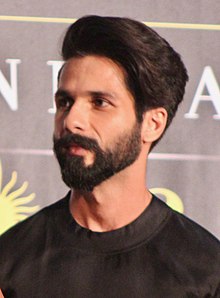
Kapoor at the 2017 IIFA Awards
Indian actor Shahid Kapoor began his career as a background dancer, making uncredited appearances in the films Dil To Pagal Hai (1997) and Taal (1999). He also appeared in several music videos, including one for the singer Kumar Sanu, before making his acting debut with a lead role in Ken Ghosh's romantic comedy Ishq Vishk (2003). The film was a sleeper hit, and Kapoor's portrayal of a teenage student earned him the Filmfare Award for Best Male Debut. He found little success in the next two years; all five of his releases, including the thriller Fida (2004) and the drama Shikhar (2005), were commercial failures.
In 2006, Kapoor starred opposite Kareena Kapoor in 36 China Town and Chup Chup Ke, and played a prospective groom opposite Amrita Rao in Vivah, a commercially successful family drama from director Sooraj Barjatya. In the following year, he reunited with Kareena Kapoor in the romantic comedy Jab We Met, for which he received his first Best Actor nomination at Filmfare. In 2009, Kapoor portrayed twin brothers, one with a lisp and the other with a stutter, in Vishal Bhardwaj's critically acclaimed thriller Kaminey. He then appeared in a series of films which performed poorly at the box-office, including Mausam (2011) and Teri Meri Kahaani (2012). The 2013 action-drama R... Rajkumar proved to be his first commercial success in four years. (Full article...) -
Image 11Thondimuthalum Driksakshiyum is a 2017 Indian Malayalam-language thriller-drama film directed by Dileesh Pothan. The film stars Fahadh Faasil, Suraj Venjaramoodu, Nimisha Sajayan, Alencier Ley Lopez, Vettukili Prakash, and Sibi Thomas. It was written by Sajeev Pazhoor along with Syam Pushkaran who was also creative director. Bijibal composed the music while Rajeev Ravi handled the cinematography.
Produced on a budget of ₹65 million, Thondimuthalum Driksakshiyum was released on 30 June 2017 and grossed ₹175 million in Kerala. The film was cited as one of the "Top 5 Malayalam movies in 2017" and "The 25 best Malayalam films of the decade" by The Hindu. The film garnered awards and nominations in several categories, with particular praise for its direction, screenplay and Fahadh's performance. The film won 36 awards from 45 nominations. (Full article...) -
Image 12Dookudu (transl. Aggression) is a 2011 Indian Telugu-language action comedy film directed by Srinu Vaitla, and jointly produced by Ram Achanta, Gopi Achanta and Anil Sunkara. The film features Mahesh Babu, Samantha, Prakash Raj, and Sonu Sood in the lead roles, and Brahmanandam, and M. S. Narayana in supporting roles. It was edited by M. R. Varma and the cinematography was provided by K. V. Guhan and Prasad Murella. The film's musical and background score were composed by S. Thaman.
Partially inspired by the 2003 German tragicomedy film Good Bye, Lenin!, Dookudu revolves around the life of police officer Ajay Kumar (Mahesh). His father Shankar Narayana (Prakash Raj) awakes from a coma, which he has been in for many years after an accident, but his health remains perilous. To aid his recovery, Kumar masquerades as a Member of the Legislative Assembly fulfilling his father's ambition for him. (Full article...) -
Image 13

Nani in 2018
Nani is an Indian actor, film producer and television presenter who works predominantly in Telugu films and appears in a few Tamil films. He made his acting debut with Mohana Krishna Indraganti's 2008 comedy film Ashta Chamma, an Indian adaptation of Oscar Wilde's play The Importance of Being Earnest. After Ashta Chamma's commercial success, Nani played the lead roles in three Telugu films in the next two years: Ride (2009), Snehituda (2009) and Bheemili Kabaddi Jattu (2010). In 2011, Nani collaborated with B. V. Nandini Reddy on the romantic comedy film Ala Modalaindi which was profitable. The same year, he made his Tamil cinema debut with Anjana Ali Khan's Veppam, a crime drama set in the backdrop of North Chennai. The following year, Nani collaborated with S. S. Rajamouli and Gautham Vasudev Menon on the Telugu-Tamil bilingual Eega and the romance film Yeto Vellipoyindhi Manasu respectively. The former, which was about a murdered man reincarnating as a housefly and avenging his death, earned Nani an award in the Best Hero category at the 2013 Toronto After Dark Film Festival. He received the Nandi Award for Best Actor for his performance in Yeto Vellipoyindhi Manasu.
Nani ventured into film production in 2013 as a co-producer for the film D for Dopidi. He faced three box office failures in the upcoming years: Paisa (2013), Aaha Kalyanam (2014) and Janda Pai Kapiraju (2015). Nani termed it a "low phase" in his career and worked on the "planning of films and the timing of their release". He then played the lead role in Nag Ashwin's Yevade Subramanyam (2015), a film focusing on a businessperson's journey to the Himalayas seeking self exploration. Nani later starred in Maruthi's comedy film Bhale Bhale Magadivoy (2015), in which he played an absent minded scientist easily prone to distraction. It was the actor's first blockbuster success, and earned him the Critics Award for Best Actor – South at the 63rd Filmfare Awards South ceremony. With his subsequent releases, the profitable ventures Krishna Gaadi Veera Prema Gaadha (2016) and Gentleman (2016), he gained stardom in Telugu cinema. Nani later played the lead in the commercially successful Telugu films Majnu (2016), Nenu Local (2017), Middle Class Abbayi (2017), and Ninnu Kori (2017). In 2018, Nani featured as the host of the second season of the Telugu game show Bigg Boss. (Full article...) -
Image 14

Kapadia at the Pichvai Exhibition in New Delhi, 2018
Dimple Kapadia is an Indian actress who predominantly appears in Hindi films. She was discovered by Raj Kapoor at age 14, who gave her the title role in his teen romance Bobby (1973), opposite his son Rishi Kapoor. The film became a massive commercial success and made her an overnight star. Her role as a Christian teenager from Goa established her as a youth fashion icon and won her the Filmfare Award for Best Actress. Kapadia retired from acting following her marriage to Indian actor Rajesh Khanna earlier in 1973, and returned to the film industry in 1984, after her separation from Khanna. The release of her comeback film, Saagar, was delayed, with Zakhmi Sher becoming the second film of her career. Released in 1985, Saagar earned her a second Best Actress award at Filmfare, and she went on to establish herself as one of the leading actresses of Hindi cinema in the 1980s and early 1990s. The early roles she played following her return included the Hitchcockian thriller Aitbaar (1985), for which she received positive reviews, and the commercially successful action films Arjun (1985) and Janbaaz (1986). During this period, she acted in several films in South India, which she admitted to having made for financial gain and dismissed their quality.
Many of Kapadia's early roles relied on her perceived beauty, and she would struggle to be taken seriously as an actress. She made a decision to accept more serious roles, and won acclaim for her role in the marital drama Kaash (1987). Financial success came with films like Insaniyat Ke Dushman (1987), Insaaf (1987), in which she played double roles; the controversial revenge saga Zakhmi Aurat (1988), in which she played an avenging rape victim; and Ram Lakhan (1989). She started the next decade by venturing into neorealist art films, known in India as parallel cinema, including Drishti (1990), Lekin... (1990), and Rudaali (1993). All these films won her critical praise, and her role as a professional mourner in the latter earned her a National Film Award for Best Actress and a Filmfare Critics Award for Best Actress. She further essayed character parts in Prahaar (1991), Angaar (1992), Gardish (1993), and Krantiveer (1994), which garnered her a fourth Filmfare Award, in the Best Supporting Actress category. (Full article...) -
Image 15
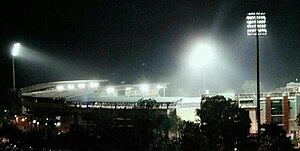
Green Park Stadium hosting the 3rd ODI between India and New Zealand.
The Green Park Stadium—formerly known as Modi Stadium—is a cricket ground in Kanpur, India. It is the home ground of the Uttar Pradesh cricket team and has played host to Ranji Trophy matches, as well as being a Test and One Day International (ODI) venue. The ground has hosted 23 Test matches, since the first one in 1952 when India played England. It has also staged 15 ODIs, the first of which was in 1986 when India lost to Sri Lanka by a margin of 17 runs. It has staged 1 T20 International in 2017.
The first century at the ground was scored by the West Indian Garfield Sobers. He made 198 during the second Test of the 1958–59 West Indies tour of India. The first Indian to score a century at the ground was Polly Umrigar, who made 147 not out against England in December 1961. West Indian Faoud Bacchus' 250, against India in February 1979, is the highest individual score by a batsman at the ground. India's Gundappa Viswanath and Mohammed Azharuddin have scored the most centuries at the venue with three each. The latter also holds the record for the highest score by an Indian at the ground. As of February 2016, 32 Test centuries have been scored at the stadium. (Full article...) -
Image 16
The Sudan Block of NDA
The Indian National Defence Academy (NDA) is the joint services academy of the Indian Armed Forces, where cadets of the three armed forces (the Army, the Navy and the Air Force) train together before beginning pre-commission training at their respective service academies (Indian Military Academy (IMA), Indian Naval Academy (INA), and Air Force Academy (AFA) for army, navy, and air force cadets respectively). Established in 1954 and located in vicinity of Khadakwasla Dam, near Pune, it is the world's first tri-service academy.
NDA is not the only officer training academy in India. Besides NDA, which is tri-service academy, the Indian Army's IMA, Officers Training Academy (OTA), Army Cadet College (ACC), the Indian Navy's INA, and the Air Force's AFA are the other officer training academies of India. Besides cadets from NDA, these academies accept cadets separately from several streams. Apart from these, the Indian Army has three establishments for technical stream which include College of Military Engineering (CME), Military College of Telecommunication Engineering (MCTE), and Military College of Electronics and Mechanical Engineering (MCEME). Although cadets are imparted technical training at these three academies, they are commissioned through OTA, Gaya. Excluding all these establishments, which are meant for combat arms, the Indian Army has other commissioning academies for support services such as the Medical Corps, and the Judge Advocate General's Department for example. (Full article...) -
Image 17
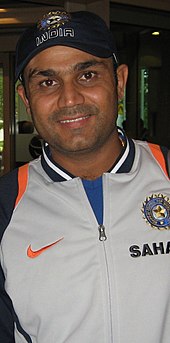
Virender Sehwag has represented Delhi Daredevils in 86 matches, more than any other player.
The Delhi Capitals are a franchise cricket team based in Delhi, India, and are one of the teams participating in the Indian Premier League (IPL). The Capitals played their first match in the first season of the IPL against the Rajasthan Royals. The Capitals reached the IPL playoffs three times, and have topped the group stage table twice. Their performances in the competition have resulted in their qualification for the 2009 and 2012 Champions League Twenty20, in which they reached the semi-finals on the second occasion. In total, 108 players have played for the Capitals, of whom Virender Sehwag has played the most matches: 86 since his debut for the franchise in 2008.
The leading run-scorer for the Capitals is Sehwag with 2,382 runs. Rishabh Pant's innings of 128 not out against the Sunrisers Hyderabad in 2018 is the highest individual score in an innings by a Capitals batsman. David Warner and Shikhar Dhawan both have scored two centuries each for the Capitals, whereas Sehwag, AB de Villiers, Kevin Pietersen, Quinton de Kock, Sanju Samson, and Pant have scored one each. JP Duminy has the team's best batting average: 44.13. Among Capitals's bowlers, Amit Mishra has taken more wickets than any other, with 90. The best bowling average is Doug Bracewell's 10.66, though among bowlers who have bowled more than 20 overs, Farveez Maharoof has the best average with 19.25. Mishra has the best bowling figures in an innings: he got a five wicket haul against the Deccan Chargers in a 2008 match, while conceding only 17 runs. Dinesh Karthik has taken the most catches as wicket-keeper for the Capitals, with 30, while also making the most stumpings: 15. Sehwag has claimed the highest number of catches among fielders, taking 30. (Full article...) -
Image 18The extreme points of India include the coordinates that are further north, south, east or west than any other location in India; and the highest and the lowest altitudes in the country. The northernmost point claimed by India is in territory disputed between India and Pakistan, and administered partially by both. With the exception of Kanyakumari, the southernmost location of mainland India, all other extreme locations are uninhabited.
The latitude and longitude are expressed in decimal degree notation, in which a positive latitude value refers to the northern hemisphere, and a negative value refers to the southern hemisphere. Similarly, a positive longitude value refers to the eastern hemisphere, and a negative value refers to the western hemisphere. The coordinates used in this article are sourced from Google Earth, which makes use of the WGS84 geodetic reference system. Additionally, a negative altitude value refers to land below sea level. (Full article...) -
Image 19The 2022 recipient: Mithun Chakraborty
The Dadasaheb Phalke Award is India's highest award in the field of cinema. It is presented annually at the National Film Awards ceremony by the Directorate of Film Festivals, an organisation set up by the Ministry of Information and Broadcasting. The recipient is honoured for their "great and outstanding contribution to the growth and development of Indian cinema" and is selected by a committee consisting of eminent personalities from the Indian film industry. The award comprises a Swarna Kamal (Golden Lotus) medallion, a shawl, and a cash prize of ₹1,000,000 (US$12,000).
Presented first in 1969, the award was introduced by the Government of India to commemorate Dadasaheb Phalke's contribution to Indian cinema. Phalke (1870–1944), who is popularly known as and often regarded as "the father of Indian cinema", was an Indian filmmaker who directed India's first full-length feature film, Raja Harishchandra (1913). (Full article...) -
Image 20

Members of the Indian cricket team before a Women's World Twenty20 game in Sydney, 2009
The India women's national cricket team represents India in international women's cricket. A full member of the International Cricket Council (ICC), the team is governed by the Board of Control for Cricket in India (BCCI). The India women's national cricket team first competed in 1976 when they played the West Indies in a six-match Test series at home. They recorded their first victory in the fourth match held at the Moin-ul-Haq Stadium, Patna; however, a loss in the sixth match led to the series being tied. India secured their first overseas victory in a one-off series against South Africa in 2002. As of October 2022[update], they have played 38 Test matches against five different opponents—Australia, England, South Africa, New Zealand and the West Indies. In terms of victories, they have been most successful against England and South Africa with two wins against each of them.
India played their first Women's One Day International cricket (WODI) match against England in the 1978 World Cup, which they hosted. They finished at the bottom of the table as they lost the remaining two games of the group stage. In the 1982 World Cup, they won their first ever WODI match when they beat the International XI by 79 runs at McLean Park, Napier. India's first overseas WODI series win came at the 1994–95 New Zealand Women's Centenary Tournament. They won the WODI series during their tour 1999 of England. They were the runner-up at the 2005 and the 2017 World Cup tournaments. As of October 2022[update], they have played 301 WODIs against twelve different opponents, and have the fourth highest number of victories (164) for any team in the format; They have recorded 81 wins and have been the fifth most successful team in the T20 format. Since their first Women's Twenty20 International (WT20I) against England in August 2006, India have played 151 matches. They have been most successful against Bangladesh with eleven wins against them. They were among the semi-finalists in the 2009 and 2010 ICC Women's World Twenty20 tournaments. (Full article...) -
Image 21
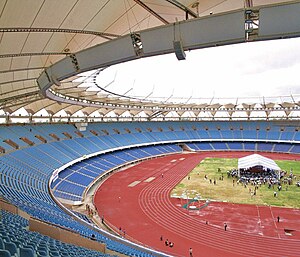
Jawaharlal Nehru Stadium as it appeared in July 2010, was the main venue for the 1982 Asiad.
The 1982 Asian Games (also known as the IX Asiad)[a] was a multi-sport event held in Delhi, India, from 12 November to 4 December 1982. A total of 3,411 athletes from 33 National Olympic Committees (NOCs) participated in these games, competing in 147 events in 21 sports and 22 disciplines. The number of participating countries was the greatest in Asian Games history. Sport events of handball, equestrian, rowing and golf were included for the first time; while fencing and bowling were excluded. This medal table ranks the participating NOCs by the number of gold medals won by their athletes.
Athletes from 23 participating NOCs won at least one medal; athletes from 16 of these NOCs secured at least one gold. Athletes from China won 61 gold medals, the most of any nation at these Asiad, and led the gold-medal count for the first time in their Asiad history. Japan had won the greatest number of medals in previous editions of the Games. China first competed at the Asian Games in 1974, in Tehran, where it finished third. Athletes from both China and Japan won the most total medals with 153. China has secured the top medal spot in every Asiad since 1982. South Korea finished third in total medals. North Korea finished fifth in total medals, and fourth in the gold-medal count. Host nation India finished the games with 57 medals overall (13 gold, 19 silver and 25 bronze, its best performance since 1951), in fifth spot in terms of total gold medals. (Full article...) -
Image 22

James Faulkner is one of the only four bowlers to take multiple five-wicket hauls and the only to take multiple five-wicket hauls in the same season.
In cricket, a five-wicket haul (also known as a "five-for" or "fifer") refers to a bowler taking five or more wickets in a single innings. This is regarded as a notable achievement, especially in T20 cricket where a bowler can bowl a maximum of only 24 balls (4 overs). The Indian Premier League (IPL) is a professional Twenty20 cricket league in India, which has been held annually since its first season in 2008. So far, 34 five-wicket hauls have been taken by different bowlers, of which only two five-wicket hauls have been taken outside India. Players from twelve of the thirteen teams have taken five-wicket hauls; Kochi Tuskers Kerala is the only franchise for which a player has not taken a five-wicket haul.
The first five-wicket haul was taken by Sohail Tanvir of the Rajasthan Royals against the Chennai Super Kings on 4 May 2008. He finished the game with 6 wickets. The most economical five-wicket haul was taken by Akash Madhwal of the Mumbai Indians, who claimed five wickets with an economy rate of 1.43 in the 2023 season. Yuzvendra Chahal of the Rajasthan Royals took the least economical five-wicket haul, 5/40 bowling with an economy rate of 10.00 in 2021. Anil Kumble is the oldest bowler to take a five-wicket haul, achieving the feat at the age of 38, while Jaydev Unadkat is the youngest, he was 21 when he took his first five-for in 2013. (Full article...) -
Image 23
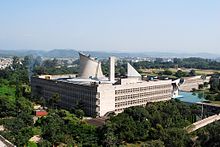
The Punjab Legislative Assembly is the unicameral state legislature of Punjab state in North India. The seat of the Legislative Assembly is at Chandigarh, the capital of the state. It is housed within the Chandigarh Capitol Complex, a World Heritage Site designed by Le Corbusier. The term of the assembly is five years, unless it is dissolved earlier. Since 1977, it has had 117 members who are directly elected, from single-seat constituencies.
Since the independence of India, the Scheduled Castes (SC) and Scheduled Tribes (ST) have been given Reservation status, guaranteeing political representation, and the Constitution lays down the general principles of positive discrimination for SCs and STs. The 2011 census of India stated that there were no people of any Scheduled Tribes in Punjab, while the Scheduled Castes constituted a significant portion of the population of the state, at 31.9%. The Scheduled Castes have been granted a reservation of 34 seats in the assembly. (Full article...) -
Image 24

The Padma Bhushan is the third-highest civilian award of the Republic of India. Instituted on 2 January 1954, the award is given for "distinguished service of a high order", without distinction of race, occupation, position, or sex. The recipients receive a Sanad, a certificate signed by the President of India and a circular-shaped medallion with no monetary association. The recipients are announced every year on Republic Day (26 January) and registered in The Gazette of India—a publication used for official government notices and released weekly by the Department of Publication, under the Ministry of Urban Development. The conferral of the award is not considered official without its publication in the Gazette. The names of recipients whose awards have been revoked or restored, both of which processes require the authority of the president, are archived and they are required to surrender their medal when their name is struck from the register; none of the conferments of Padma Bhushan during 2000–2009 have been revoked or restored. The recommendations are received from all the state and the union territory governments, as well as from Ministries of the Government of India, the Bharat Ratna and the Padma Vibhushan awardees, the Institutes of Excellence, the Ministers, the Chief Ministers and the Governors of State, and the Members of Parliament including private individuals.
When instituted in 1954, the Padma Bhushan was classified as "Dusra Varg" (Class II) under the three-tier Padma Vibhushan awards, which were preceded by the Bharat Ratna in hierarchy. On 15 January 1955, the Padma Vibhushan was reclassified into three different awards as the Padma Vibhushan, the Padma Bhushan and the Padma Shri. The criteria included "distinguished service of a high order in any field including service rendered by Government servants", but excluded those working with the public sector undertakings with the exception of doctors and scientists. The 1954 statutes did not allow posthumous awards; this was subsequently modified in the January 1955 statute. The design was also changed to the form that is currently in use; it portrays a circular-shaped toned bronze medallion 1+3⁄4 inches (44 mm) in diameter and 1⁄8 inch (3.2 mm) thick. The centrally placed pattern made of outer lines of a square of 1+3⁄16 inches (30 mm) side is embossed with a knob carved within each of the outer angles of the pattern. A raised circular space of diameter 1+1⁄16 inches (27 mm) is placed at the centre of the decoration. A centrally located lotus flower is embossed on the obverse side of the medal and the text "Padma" is placed above and the text "Bhushan" is placed below the lotus written in Devanagari script. The State Emblem of India is displayed in the centre of the reverse side, together with the national motto of India, "Satyameva Jayate" (Truth alone triumphs) in Devanagari script, which is inscribed on the lower edge. The rim, the edges and all embossing on either side is of standard gold with the text "Padma Bhushan" of gold gilt. The medal is suspended by a pink riband 1+1⁄4 inches (32 mm) in width with a broad white stripe in the middle. It is ranked fifth in the order of precedence of wearing of medals and decorations of the Indian civilian and military awards. (Full article...) -
Image 25

Matondkar in 2010
Urmila Matondkar is an Indian actress known for her work in Hindi films. She has appeared in over 60 films. She has been praised by the critics for her acting and dancing skills. She made her screen debut as a child artist in B.R. Chopra's Karm (1977), and later appeared in Shekhar Kapur's critically acclaimed Masoom (1983). After making her debut as the heroine in 1989 Malayalam thriller Chanakyan, Urmila began a full-time acting career, with a leading role in the 1991 action Narsimha. She rose to prominence with Ram Gopal Varma's blockbuster Rangeela (1995). Her portrayal of an aspiring actress, Mili Joshi, opposite Aamir Khan received praise from critics, and garnered her first nomination for the Filmfare Award for Best Actress.
In 1997, Urmila received a nomination for Filmfare Award for Best Supporting Actress for her performance in the drama Judaai. The following year, she starred in the crime drama Satya, which has been cited as one of the greatest films of Indian cinema, for which she received another nomination for Best Actress. The same year, her dance performance in the item number "Chamma Chamma" from China Gate won her rave reviews. In 1999, she received praise for playing a psychopath in the thriller Kaun and a reserved girl in the romantic comedy Khoobsurat, a box office success. Her other four releases of the year including Jaanam Samjha Karo, and Hum Tum Pe Marte Hain were commercial failures. She played an obsessive lover in the 2001 romantic drama Pyaar Tune Kya Kiya, which earned her a nomination for the Filmfare Award for Best Performance in a Negative Role. (Full article...)
 Good article – show another
Good article – show another
-
Image 1

The balcony of Rajasthan Royals during the match.
The British Asian Cup was a day/night Twenty20 cricket charity match played between the 2008 Indian Premier League (IPL) champion Rajasthan Royals and the 2008 Twenty20 Cup champion Middlesex Panthers played at the Lord's Cricket Ground, London, England. A portion of the earnings of the match went to the British Asian Trust. It ended as the Royals defeated the Panthers by 46 runs.
Shaun Udal and Shane Warne were the captains for the Panthers and the Royals respectively. The Royals played a warm-up game with the Middlesex Second XI before the match, and won it by 28 runs. The match attracted a crowd of 20,000 people, but was delayed due to rain. (Full article...) -
Image 2
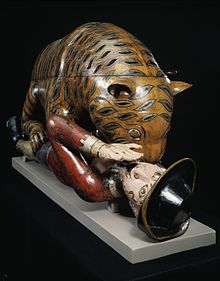
Tipu's Tiger in the V&A Museum, London showing the prostrate European being attacked
Tipu's Tiger, Tippu's Tiger or Tipoo’s Tiger is an 18th-century automaton created for Tipu Sultan, the ruler of the Kingdom of Mysore (present day Karnataka) in India. The carved and painted wood casing represents a tiger mauling a near life-size European man. Mechanisms inside the tiger and the man's body make one hand of the man move, emit a wailing sound from his mouth and grunts from the tiger. In addition a flap on the side of the tiger folds down to reveal the keyboard of a small pipe organ with 18 notes.
The automaton incorporates Tipu's emblem, the tiger, and expresses his hatred of his enemy, the British of the East India Company. It was taken from his summer palace when East India Company troops stormed Tipu's capital in 1799. The Governor General, Lord Mornington, sent the tiger to Britain initially intending it to be an exhibit in the Tower of London. First exhibited to the London public in 1808 in East India House, then the offices of the East India Company in London, it was transferred to the Victoria and Albert Museum in 1880. It now forms part of the permanent exhibit on the "Imperial courts of South India". From the moment it arrived in London to the present day, Tipu's Tiger has been a popular attraction to the public. (Full article...) -
Image 3
Narendra Damodardas Modi (born 17 September 1950) is an Indian politician who has been serving as the Prime Minister of India since 2014. Modi was the chief minister of Gujarat from 2001 to 2014 and is the member of parliament (MP) for Varanasi. He is a member of the Bharatiya Janata Party (BJP) and of the Rashtriya Swayamsevak Sangh (RSS), a right-wing Hindu nationalist paramilitary volunteer organisation. He is the longest-serving prime minister outside the Indian National Congress.
Modi was born and raised in Vadnagar in northeastern Gujarat, where he completed his secondary education. He was introduced to the RSS at the age of eight. At the age of 18, he was married to Jashodaben Modi, whom he abandoned soon after, only publicly acknowledging her four decades later when legally required to do so. Modi became a full-time worker for the RSS in Gujarat in 1971. The RSS assigned him to the BJP in 1985 and he rose through the party hierarchy, becoming general secretary in 1998. In 2001, Modi was appointed Chief Minister of Gujarat and elected to the legislative assembly soon after. His administration is considered complicit in the 2002 Gujarat riots, and has been criticised for its management of the crisis. According to official records, a little over 1,000 people were killed, three-quarters of whom were Muslim; independent sources estimated 2,000 deaths, mostly Muslim. A Special Investigation Team appointed by the Supreme Court of India in 2012 found no evidence to initiate prosecution proceedings against him. While his policies as chief minister were credited for encouraging economic growth, his administration was criticised for failing to significantly improve health, poverty and education indices in the state. (Full article...) -
Image 4The Hindu–German Conspiracy(Note on the name) was a series of attempts between 1914 and 1917 by Indian nationalist groups to create a Pan-Indian rebellion against the British Empire during World War I. This rebellion was formulated between the Indian revolutionary underground and exiled or self-exiled nationalists in the United States. It also involved the Ghadar Party, and in Germany the Indian independence committee in the decade preceding the Great War. The conspiracy began at the start of the war, with extensive support from the German Foreign Office, the German consulate in San Francisco, and some support from Ottoman Turkey and the Irish republican movement. The most prominent plan attempted to foment unrest and trigger a Pan-Indian mutiny in the British Indian Army from Punjab to Singapore. It was to be executed in February 1915, and overthrow British rule in the Indian subcontinent. The February mutiny was ultimately thwarted when British intelligence infiltrated the Ghadarite movement and arrested key figures. Mutinies in smaller units and garrisons within India were also crushed.
The Indo-German alliance and conspiracy were the target of a worldwide British intelligence effort, which successfully prevented further attempts. American intelligence agencies arrested key figures in the aftermath of the Annie Larsen affair in 1917. The conspiracy resulted in the Lahore conspiracy case trials in India as well as the Hindu–German Conspiracy Trial — at the time the longest and most expensive trial ever held in the United States. (Full article...) -
Image 5
Ankita Bhakat (born 17 June 1998) is an Indian recurve archer from West Bengal, who is currently ranked world number 20 by the World Archery Federation. She is a member of the Indian national recurve team and competes in international events in the women's individual, women's team and the mixed team recurve categories. She competed in the 2017 World Archery Youth Championships held at Rosario, Argentina, and won the gold medal in the recurve junior mixed team event with partner Jemson Singh Ningthoujam. (Full article...) -
Image 6
PSLV-C42 was the 44th mission of the Indian Polar Satellite Launch Vehicle (PSLV) program and its 12th mission in the Core Alone (CA) configuration. PSLV-C42 successfully carried and deployed 2 Earth observation satellites in Sun-synchronous orbits at an altitude of 588 kilometres (365 mi). It was launched on 16 September 2018 by the Indian Space Research Organisation (ISRO) from the first launch pad of the Satish Dhawan Space Centre at Sriharikota, Andhra Pradesh. The two international satellites were launched as part of a commercial arrangement between Surrey Satellite Technology Limited (SSTL) and ISRO's commercial arm Antrix Corporation Limited, run under the auspices of the Indian Government's Department of Space. (Full article...) -
Image 7Ventilator is a 2016 Indian Marathi-language comedy drama film written and directed by Rajesh Mapuskar and produced by Priyanka Chopra. The film features an ensemble cast of more than 100 actors, including Ashutosh Gowariker, Jitendra Joshi, Sulbha Arya and Sukanya Kulkarni. It tells the story of the Kamerkar family, whose eldest and most beloved member goes into a coma and is put on a medical ventilator a few days before the Ganesh Chaturthi festival celebrations.
Mapuskar conceived the film after one of his family members was hospitalised and put on a ventilator; he started writing the script after noting the reaction of his family members, trying to treat the difficult situation with humour. On its completion, he approached several producers, who were sceptical and tried to discourage him from making it in Marathi. Later, Chopra accepted it to produce under her production company Purple Pebble Pictures. (Full article...) -
Image 8

The 1960 North Indian Ocean cyclone season featured two deadly tropical cyclones that collectively killed approximately 20,000 people collectively in East Pakistan (present-day Bangladesh). The Indian subcontinent divides the North Indian Ocean into two areas: the Bay of Bengal to the east and the Arabian Sea to the west. The official Regional Specialized Meteorological Centre for this basin is the India Meteorological Department (IMD), while the Joint Typhoon Warning Center releases unofficial advisories. On average, five storms form in the North Indian Ocean every season with dual peaks in activity during May and November. Cyclones that occurred between 45°E and 100°E were included in seasonal records by the IMD.
Fifteen depressions developed during the 1960 season, with five becoming cyclonic storms. The majority of the activity took place in the Bay of Bengal, where eleven systems formed; however, the season's first storm formed over the Arabian Sea on May 10. The storm produced hurricane-force winds and attained a barometric air pressure of 974 mbar (hPa; 28.76 inHg). The deadliest and most intense cyclone of the season was Severe Cyclonic Storm Ten, which killed 14,174 in East Pakistan in early November. With peak winds estimated at 150 km/h (95 mph) and a pressure of 966.7 mbar (hPa; 28.55 inHg), it struck just three weeks after the previous system devastated the same area. The storm produced a 6.1 m (20 ft) storm tide that swept 16 km (10 mi) inland, submerging several small islands. The two storms left a combined 200,000–300,000 people homeless. These systems marked the start of an unusually active period of cyclones impacting East Pakistan, culminating ten years later with the 1970 Bhola cyclone, which killed between 300,000 and 500,000 people. During the 1960 season, several depressions impacted India with heavy rainfall. Collectively, these systems killed 167 people. (Full article...) -
Image 9Statue of Shiva at Shivoham Shiva Temple, Bangalore, Karnataka
Shiva (/ˈʃɪvə/; Sanskrit: शिव, lit. 'The Auspicious One', IAST: Śiva [ɕɪʋɐ]), also known as Mahadeva (/məˈhɑː ˈdeɪvə/; Sanskrit: महादेव:, lit. 'The Great God', IAST: Mahādevaḥ, (Full article...) -
Image 10Vanaja is a 2006 Telugu-language drama film written and directed by Rajnesh Domalpalli on a story that constituted his Master of Fine Arts thesis at Columbia University. The film was made on a shoestring budget using a cast of non-professional first-timers for two and a half months.
The film stars Mamatha Bhukya as the title character: a 15-year-old daughter of a poor fisherman set in the backdrop of a rustic state of Andhra Pradesh in Southern India. She learns Kuchipudi, a classical Indian dance form, while being employed at a local landlady's house. All seems to be going well for her until sexual chemistry evolves between her and the landlady's son, and this eventually leads her being raped by him. The ensuing pregnancy disrupts her simple life, and she must choose how to deal with the child. (Full article...) -
Image 11
Phumdi (Meitei pronunciation: /pʰúm.dí/), also known as Phumthi (Meitei pronunciation: /pʰúm.tʰí/) or simply Phum (Meitei pronunciation: /pʰúm/), are a series of floating islands, exclusive to the Loktak Lake in Manipur state, in northeastern India. They cover a substantial part of the lake area and are heterogeneous masses of vegetation, soil and organic matter, in different stages of decay. The largest single mass of phumdi is in the southeastern part of the lake, covering an area of 40 km2 (15.4 sq mi). This mass constitutes the world’s largest floating park, named Keibul Lamjao National Park. The park was formed to preserve the endangered Eld's deer subspecies, called sangai in the Meitei language, indigenous to this area.
Phumdis are used by the local people for constructing their huts for fishing and other livelihood uses, and are inhabited by about 4000 people. Athapums are artificial circular phumdis, built by the villagers as enclosures for fish farming; aquaculture has caused proliferation of the phumdis in the lake. (Full article...) -
Image 12The 2015–16 season was the third in the history of Bengaluru Football Club. It began on 1 June 2015 and concluded on 31 May 2016, with competitive matches occurring between January and May. The club ended their I-League campaign as champions for the second time, only winning by two points ahead of second placed Mohun Bagan. In the Federation Cup, Bengaluru were eliminated early in the first round, suffering defeat to Aizawl. In the AFC Cup, Bengaluru managed to make it past the Round of 16, defeating Kitchee. The victory had qualified the club for the quarter-finals which would take place the next season.
Prior to the start of the season, Bengaluru were very active making squad changes. Players who have been with the club since their first season such as Sean Rooney and domestic players Darren Caldeira, Malemngamba Meitei, Pawan Kumar, and Robin Singh left after their contracts expired. Club captain Sunil Chhetri and midfielder Thoi Singh had also left the club for Indian Super League clubs Mumbai City and Chennaiyin respectively. Both would return on loan after the 2015 ISL season. Forward Kim Song-yong was signed by head coach Ashley Westwood to replace Rooney. Midfielder Michael Collins was signed a couple weeks after the start of the I-League season as an injury replacement to Josh Walker. Indian youth internationals Amrinder Singh and Seiminlen Doungel were also brought in by Westwood, alongside young prospects Daniel Lalhlimpuia, Malsawmzuala, and Nishu Kumar from the AIFF Elite Academy. (Full article...) -
Image 13
The jungle cat (Felis chaus), also called reed cat and swamp cat, is a medium-sized cat native from the Eastern Mediterranean region and the Caucasus to parts of Central, South and Southeast Asia. It inhabits foremost wetlands like swamps, littoral and riparian areas with dense vegetation. It is listed as Least Concern on the IUCN Red List, and is mainly threatened by destruction of wetlands, trapping and poisoning.
The jungle cat has a uniformly sandy, reddish-brown or grey fur without spots; melanistic and albino individuals are also known. It is solitary in nature, except during the mating season and mother–kitten families. (Full article...) -
Image 14
Parineeti Chopra (pronounced [pəriːniːt̪iː ˈtʃoːpɽaː]; born 22 October 1988) is an Indian actress and singer who primarily works in Hindi films. Chopra is a recipient of several accolades, including a Filmfare and a National Film Award. Chopra has appeared in Forbes India's Celebrity 100 list since 2013.
After obtaining a triple honours degree in business, finance and economics from Manchester Business School, Chopra made her acting debut with the 2011 romantic comedy Ladies vs Ricky Bahl, winning the Filmfare Award for Best Female Debut. She followed it by garnering acclaim for her starring roles in the box-office hits Ishaqzaade (2012), Shuddh Desi Romance (2013) and Hasee Toh Phasee (2014). The first of these won her the National Film Award – Special Mention. This success was followed by a three-year hiatus and several poorly received films, with the exception of the horror-comedy Golmaal Again (2017) and the war drama Kesari (2019), in which she had brief role. Chopra has since earned praise for her roles in the black comedy Sandeep Aur Pinky Faraar (2021) and the biographical drama Amar Singh Chamkila (2024), and had a supporting role in the ensemble film Uunchai (2022). (Full article...) -
Image 15The 2006 Kolkata leather factory fire was a deadly industrial fire that occurred in West Bengal, India, on 22 November 2006. The fire broke out in a leather bag factory located in the Tannix International, Topsia, in the South 24 Parganas district in Greater Kolkata area, and generated a wave of criticism of the poor safety standards in place among the country's sweatshops.
The industrial fire claimed the lives of at least ten people, who were unable to escape because the doors were locked shut illegally. Authorities, in response to local residents' angry criticism, admitted that the emergency response to the accident was substandard. Two separate investigations were launched. One inquiry focused on the fire itself, while the other sought to ascertain criminal responsibility for the disaster as well as the operation of the illegal factory. The results of both are either pending or have yet to be released to the general public. (Full article...) -
Image 16
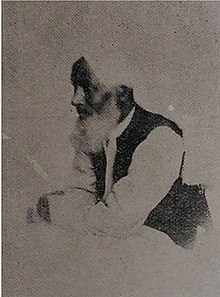
Mahmud Hasan Deobandi (also known as Shaykh al-Hind; 1851–1920) was an Indian Muslim scholar and an activist of the Indian independence movement, who co-founded the Jamia Millia Islamia University and launched the Silk Letter Movement for the freedom of India. He was the first student to study at the Darul Uloom Deoband seminary. His teachers included Muhammad Qasim Nanawtawi and Mahmud Deobandi, and he was authorized in Sufism by Imdadullah Muhajir Makki and Rashid Ahmad Gangohi.
Hasan served as the principal of the Darul Uloom Deoband and founded organisations such as the Jamiatul Ansar and the Nizaratul Maarif. He wrote a translation of the Quran in Urdu and authored books such as Adilla-e-Kāmilah, Īzah al-adillah, Ahsan al-Qirā and Juhd al-Muqill. He taught hadith at the Darul Uloom Deoband and copyedited the Sunan Abu Dawud. His major students included Ashraf Ali Thanwi, Anwar Shah Kashmiri, Hussain Ahmad Madani, Kifayatullah Dehlawi, Sanaullah Amritsari and Ubaidullah Sindhi. (Full article...) -
Image 17
Jahanpanah was the fourth medieval city of Delhi established in 1326–1327 by Delhi Sultan, Muhammad bin Tughlaq. To counter the persistent threat of Mongol invasions, Tughlaq constructed the fortified city of Jahanpanah (meaning "Refuge of the World" in Persian), incorporating the Adilabad Fort, built in the 14th century, along with all the establishments located between Qila Rai Pithora and Siri Fort. Neither the city nor the fort has survived. Many reasons have been offered for such a situation. One of these is exemplified by the idiosyncratic rule of Mohammed bin Tughlaq, who inexplicably decreed the capital to be moved to Daulatabad in the Deccan, only to return to Delhi soon after.
The ruins of the city's walls are even now discerned in the road between Siri to Qutub Minar, and also in isolated patches behind the Indian Institute of Technology (IIT), in Begumpur, Khirki Masjid, Satpula and many other nearby locations; at some sections, as seen at Satpula, the fort walls were large enough to have few inbuilt storerooms to stack provisions and armoury. The mystery of the city's precincts (complex) has unfolded over the years with later day excavations revealing a large number of monuments in the villages and residential colonies of South Delhi. (Full article...) -
Image 18Maria Mies (6 February 1931 – 15 May 2023) was a German professor of sociology, a Marxist feminist, an activist for women's rights, and an author. She came from a rural background in the Volcanic Eifel, and initially trained to be a teacher. After working for several years as a primary school teacher and qualifying as a high school instructor, she applied to the Goethe Institute, hoping to work in Africa or Asia. Assigned to a school in Pune, India, she discovered that while her male students took German courses to further their education, women for the most part took her classes to avoid marriage. Returning to study at the University of Cologne, she prepared her dissertation about contradictions of social expectations for women in India in 1971, earning her PhD the following year.
Mies was active in social movements from the late 1960s. Her activism was in favour of women's liberation and pacifism and against the Vietnam War and nuclear armaments. She taught sociology at the Cologne University of Applied Sciences and University of Frankfurt Institute for Social Research in the 1970s. Becoming aware of the lack of knowledge about women's history, she helped found and then gave lectures at the first women's shelter in Germany. In 1979, she began teaching women's studies at the International Institute of Social Studies in The Hague and founded a master's degree programme for women from developing countries, based on feminist theory. (Full article...) -
Image 19Govindudu Andarivadele (transl. The lord is a people's man), also known by the acronym GAV, is a 2014 Indian Telugu-language action drama film written and directed by Krishna Vamsi. Produced by Bandla Ganesh for Parameswara Art Productions, the film stars Ram Charan Teja, Kajal Aggarwal, Srikanth, Kamalinee Mukherjee, Prakash Raj, Jayasudha, Rahman and Adarsh Balakrishna. Yuvan Shankar Raja composed the film's soundtrack and score while Sameer Reddy worked as the cinematographer, and Naveen Nooli was the film's editor.
The film is partially inspired by the 1991 Telugu film Seetharamayya Gari Manavaralu directed by Kranthi Kumar. Govindudu Andarivadele portrays a "non-resident Indian" named Abhiram who visits his grandfather Balaraju's house as a student of agriculture. He actually came to reconcile the differences between his father, Chandrasekhar Rao, and Balaraju. The pair parted ways as Chadrasekhar went to the UK while Balaraju stayed and built a charitable hospital for local people. Abhiram succeeds in winning over family members, and Balaraju understands the truth behind Abhiram and his attempts. (Full article...) -
Image 20
Avul Pakir Jainulabdeen Abdul Kalam BR (/ˈəbdʊl kəˈlɑːm/ ⓘ; 15 October 1931 – 27 July 2015) was an Indian aerospace scientist and statesman who served as the 11th president of India from 2002 to 2007. Born and raised in a Muslim family in Rameswaram, Tamil Nadu, he studied physics and aerospace engineering. He spent the next four decades as a scientist and science administrator, mainly at the Defence Research and Development Organisation (DRDO) and Indian Space Research Organisation (ISRO) and was intimately involved in India's civilian space programme and military missile development efforts. He thus came to be known as the Missile Man of India for his work on the development of ballistic missile and launch vehicle technology. He also played a pivotal organisational, technical, and political role in India's Pokhran-II nuclear tests in 1998, the first since the original nuclear test by India in 1974.
Kalam was elected as the 11th president of India in 2002 with the support of both the ruling Bharatiya Janata Party and the then-opposition Indian National Congress. Widely referred to as the "People's President", he returned to his civilian life of education, writing and public service after a single term. He was a recipient of several prestigious awards, including the Bharat Ratna, India's highest civilian honour. (Full article...) -
Image 21
Huma Saleem Qureshi (pronounced [ˈɦʊmaː səˈliːm qʊˈɾɛːʃiː]; born 28 July 1986) is an Indian actress who primarily appears in Hindi-language films. Her accolades include a Filmfare OTT Award along with nominations for three Filmfare Awards.
Qureshi studied history in Delhi while she worked as a theatre actor and model. She then moved to Mumbai and signed a two-year contract with Hindustan Unilever to appear in television commercials. During the shoot for a Samsung mobile commercial, Anurag Kashyap noticed her acting ability and signed her for a three-film deal with his company, marking her film debut with a supporting role in the two-part 2012 crime drama Gangs of Wasseypur. Her performance in the film earned her a nomination for the Filmfare Award for Best Supporting Actress. (Full article...) -
Image 22
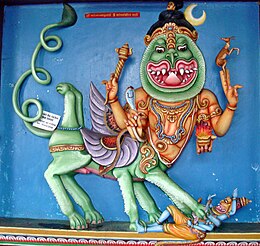
Shiva as Sharabha subduing Narasimha, panel view from Munneswaram temple in Sri Lanka
Sharabha (Sanskrit: शरभ, Śarabha) or Sarabha is an eight-legged part-lion and part-bird deity in Hindu religion, who is described as more powerful than a lion or an elephant, possessing the ability to clear a valley in one jump in Sanskrit literature. In later literature, Sharabha is described as an eight-legged deer.
The Shiva scriptures narrate that the deity Shiva assumed the form of Sharabha to pacify Narasimha - the fierce man-lion avatar of Vishnu worshipped by the Vaishnava sect. This form is popularly known as Sharabheshvara ("Lord Sharabha") or Sharabheshvaramurti. Vaishnavas refute the portrayal of Narasimha as being destroyed by Shiva-Sharabha, and regard Sharabha as a name of Vishnu. Some Vaishnava scriptures such as the Narasimha Purana suggest that Vishnu assumed the form of the ferocious two-headed bird Gandabherunda, who in turn defeated Sharabha. (Full article...) -
Image 23

The Upanishads (/ʊˈpʌnɪʃədz/; Sanskrit: उपनिषद्, IAST: Upaniṣad, pronounced [ˈʊpɐnɪʂɐd]) are late Vedic and post-Vedic Sanskrit texts that "document the transition from the archaic ritualism of the Veda into new religious ideas and institutions" and the emergence of the central religious concepts of Hinduism. They are the most recent addition to the Vedas, the oldest scriptures of Hinduism, and deal with meditation, philosophy, consciousness, and ontological knowledge. Earlier parts of the Vedas dealt with mantras, benedictions, rituals, ceremonies, and sacrifices.
While among the most important literature in the history of Indian religions and culture, the Upanishads document a wide variety of "rites, incantations, and esoteric knowledge" departing from Vedic ritualism and interpreted in various ways in the later commentarial traditions. The Upanishads are widely known, and their diverse ideas, interpreted in various ways, informed later traditions of Hinduism. The central concern of all Upanishads is to discover the relations between ritual, cosmic realities (including gods), and the human body/person, postulating Ātman and Brahman as the "summit of the hierarchically arranged and interconnected universe", but various ideas about the relation between Atman and Brahman can be found. (Full article...) -
Image 24
The 2001 Gujarat cyclone was the third strongest tropical cyclone, in terms of barometric pressure, to form in the Arabian Sea on record; only Cyclones Gonu in 2007 and Kyarr in 2019 were stronger. The storm originated from a tropical disturbance that formed east of Somalia on May 18. Over the following few days, the system gradually organized into a tropical depression. Tracking eastward, towards the coastline of southwestern India, the storm slowly intensified. Shortly before reaching shore, the system turned north and later west, away from land. After taking this turn, the storm intensified into a very severe cyclonic storm, attaining its peak intensity on May 24 with winds of 215 km/h (130 mph 3-minute winds) and a barometric pressure of 932 mbar (hPa). At the time, this ranked the cyclone as the strongest known storm in the Arabian Sea.
After stalling several hundred kilometres offshore, the storm weakened over cooler waters that it had upwelled. By May 27, the system weakened to a cyclonic storm and by this time was approaching the northwestern coastline of India, near Gujarat. The following day, the storm made landfall in the Saurashtra region as a deep depression with winds of 55 km/h (35 mph 3-minute winds). The depression quickly weakened after moving inland and dissipated early on May 29. (Full article...) -
Image 25
Chhinnamasta (Sanskrit: छिन्नमस्ता, Chinnamastā :"She whose head is severed"), often spelled Chinnamasta, and also called Chhinnamastika, Chhinnamasta Kali, Prachanda Chandika and Jogani Maa (in western states of India), is a Hindu goddess (Devi). She is one of the Mahavidyas, ten goddesses from the esoteric tradition of Tantra, and a ferocious aspect of Mahadevi, the Hindu Mother goddess. The self-decapitated nude goddess, usually standing or seated on a divine copulating couple, holding her own severed head in one hand and a scimitar in another. Three jets of blood spurt out of her bleeding neck and are drunk by her severed head and two attendants.
Chhinnamasta is a goddess of contradictions. She symbolises both aspects of Devi: a life-giver and a life-taker. She is considered both a symbol of sexual self-control and an embodiment of sexual energy, depending upon interpretation. She represents death, temporality, and destruction as well as life, immortality, and recreation. The goddess conveys spiritual self-realization and the awakening of the kundalini – spiritual energy. The legends of Chhinnamasta emphasise her self-sacrifice – sometimes coupled with a maternal element – sexual dominance, and self-destructive fury. (Full article...)
News
- 17 January 2025 – Naxalite–Maoist insurgency
- Twelve Naxalites are killed during a police raid in Bijapur, Chhattisgarh, India. (Al Jazeera)
- 16 January 2025 – 2025 in spaceflight
- The twin satellites SDX01 and SDX02 of the SpaDeX mission, launched in December by the Indian Space Research Organisation, successfully conduct India's first spacecraft docking, with India becoming the fourth country to successfully dock a spacecraft after the United States, Russia, and China. (BBC News)
- 11 January 2025 – 2024–25 South-West Indian Ocean cyclone season
- France places the Indian Ocean island of Mayotte on red alert due to approaching Tropical Cyclone Dikeledi, roughly one month after the French overseas department was devastated by Cyclone Chido. (Reuters)
- 8 January 2025 – Deadly human stampedes in Hindu temples
- Six people are killed and over forty others are injured in a stampede at the Hindu Venkateswara Temple in Tirupati, Andhra Pradesh, India. (AP) (Business Today)
- 7 January 2025 – HMPV outbreak in East Asia
- India confirms their first cases of the human metapneumovirus disease. (CBS News)
Did you know...
- ... that the first known texts written by Brazilian indigenous people, written in 1645, were only completely translated in 2021?
- ... that in 1943, Bhicoo Batlivala led a group of Indian women to the House of Commons to request the release of Gandhi from prison?
- ... that there is a dispute within the Indian communist movement on whether the Communist Party of India was founded in Tashkent in 1920 or Kanpur in 1925?
- ... that in 1935, Indian princess Indira Devi secretly travelled to London to become an actress, telling only her two sisters?
- ... that niwar, a material used for weaving cots, was once produced in Indian jails?
- ... that Arthur France founded the Leeds West Indian Carnival, the first Caribbean carnival in Europe, in 1967?
Topics related to India
Timeline of Indian history, Indus Valley Civilisation, Dholavira, Science and technology in ancient India, Meluhha, Aryan invasion theory, Out of India theory, Greek conquests in India, Indian maritime history, Maurya Empire, Ashoka, Shunga Empire, Hoysala Empire, Vijayanagara, Satavahana dynasty, Indo-Greek Kingdom, Indo-Scythians, Indo-Parthian Kingdom, Kushan Empire, Western Satraps, Gupta Empire, Chola dynasty, Pala Empire, Islamic incursions in India, Mughal Empire, Maratha Empire, British Raj, East India Company, Governor-General, Viceroy, War of Independence, 1857, Indian independence movement, Indian National Army, Azad Hind, Quit India Movement, Partition of India, History of Republic of India, Non-Aligned Movement, Sino-Indian War, Indo-Pakistani War of 1947–1948, Indo-Pakistani War of 1965, Indo-Pakistani War of 1971, Kargil War, 2001–02 India–Pakistan standoff, Military, Demographic
Law, Hindu law, Constitution, Political parties (Indian National Congress, Bharatiya Janata Party), Foreign relations, Elections, Political divisions, Reservation in India
Government agencies, Legislative branch (Lok Sabha, Rajya Sabha) Executive branch (President & Vice President, Prime Minister & Deputy Prime Minister, Cabinet Ministers, Cabinet Secretary, Election Commission, Foreign Minister; Law enforcement: CBI, CID, Intelligence: IB, RAW), Directorate General of Income Tax Investigation Judicial branch (Supreme Court), Armed Forces (Army, Navy, Air Force, Border Security Force, Coast Guard)
Himalayas, Western Ghats, Eastern Ghats, Indo-Gangetic Plain, Deccan Plateau, Thar Desert, Ganges, Rann of Kutch, Brahmaputra River, Northeast India; Mountains, Valleys, Islands, Rivers; States and union territories, Cities, Districts, Regions, Fauna, Flora
Rupee, Bombay Stock Exchange, National Stock Exchange, Standard of living, Companies, Reserve Bank of India, Energy policy (Solar, Wind, Nuclear), Tourism, Transport (Expressways, Rail transport, Auto rickshaw),
Languages, Standard of living, Religion
Music (Carnatic, Hindustani, Indi-pop), Dance, Languages, Literature, Architecture, Film & TV, Cuisine, Holidays, Folklore, Education, Media, Indian martial arts
Indian Council of Agricultural Research (ICAR), Indian Institute of Astrophysics, National Centre for Software Technology, AIIMS, IISc, IIT, NIT, BITS-Pilani, INRegistry, Indian numbering system, Indian Space Research Organisation, National Internet Exchange of India, ICRISAT, International Institute of Information Technology, Hyderabad
Indian English, Indian nationality law, Numbering system, Indian Space Research Organisation, Telecommunications, National Highways Development Project, Flag, Vehicle registration plates, Indian nationalism, Metrication in India
Categories
Related portals
Religions in India
Indian Subcontinent
Other countries
Wikipedias in Indian languages
- অসমীয়া (Assamese)
- বাংলা (Bengali)
- भोजपुरी (Bhojpuri)
- বিষ্ণুপ্রিয়া মণিপুরী (Bishnupriya Manipuri)
- गोंयची कोंकणी / Gõychi Konknni (Konkani)
- ગુજરાતી (Gujarati)
- हिन्दी (Hindi)
- ಕನ್ನಡ (Kannada)
- कॉशुर/كشميري (Kashmiri)
- मैथिली (Maithili)
- മലയാളം (Malayalam)
- मराठी (Marathi)
- नेपाली (Nepali)
- नेपाल भाषा
- (Newari)
- ଓଡ଼ିଆ (Odiya)
- ਪੰਜਾਬੀ (Punjabi)
- पालि (Pali)
- संस्कृत (Sanskrit)
- ᱥᱟᱱᱛᱟᱲᱤ (Santali)
- سنڌي (Sindhi)
- தமிழ் (Tamil)
- తెలుగు (Telugu)
- ತುಳು (Tulu)
- اردو (Urdu)
Associated Wikimedia
The following Wikimedia Foundation sister projects provide more on this subject:
-
Commons
Free media repository -
Wikibooks
Free textbooks and manuals -
Wikidata
Free knowledge base -
Wikinews
Free-content news -
Wikiquote
Collection of quotations -
Wikisource
Free-content library -
Wikiversity
Free learning tools -
Wikivoyage
Free travel guide -
Wiktionary
Dictionary and thesaurus
- Pages with Hindi IPA
- Pages with Kannada IPA
- Pages using the Phonos extension
- Pages with Telugu IPA
- Pages including recorded pronunciations
- Pages with Urdu IPA
- Pages with Nepali (macrolanguage) IPA
- Pages with Bengali IPA
- Pages with Sanskrit IPA
- Pages with Hindustani IPA
- Portals with triaged subpages from June 2018
- All portals with triaged subpages
- Portals with no named maintainer
- Automated article-slideshow portals with 51–100 articles in article list
- Automated article-slideshow portals with 101–200 articles in article list
- Automated article-slideshow portals with 501–1000 articles in article list
- Wikipedia move-protected portals
- Redirect targets of redirected portals with existing subpages











